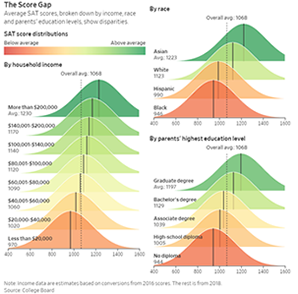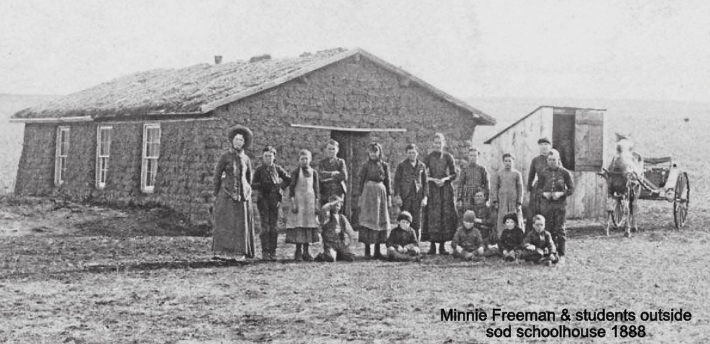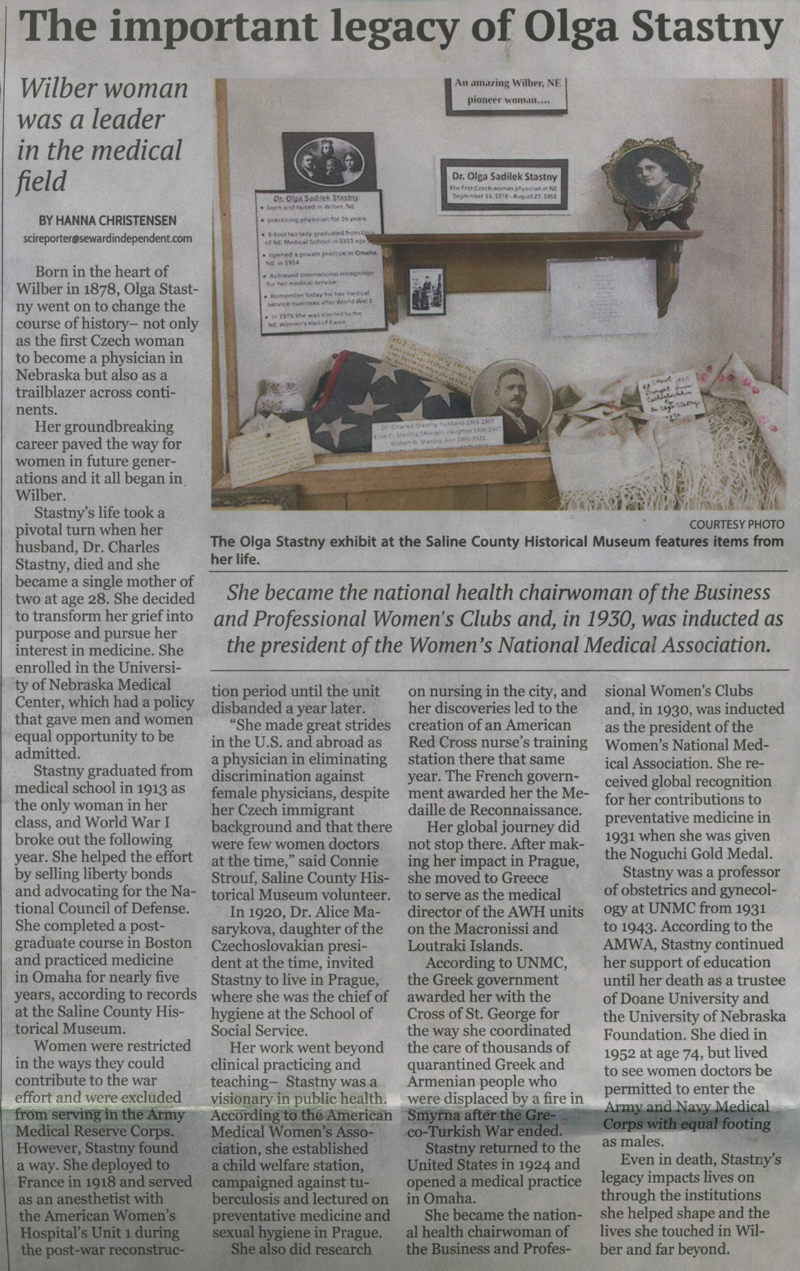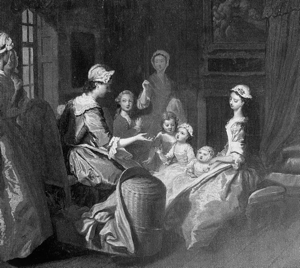Timeline of people & events that develop American education
Every decision in education is political.
Introduction
Content outline
- Introduction
- Timeline - Today
- Summary professional educator changes
- 2002
- Twentieth century (1900's)
- Summary of ideas that influenced the Twentieth Century
- 1985
- Summary of instructional changes in the 60's, 70's and beyond
- 1954
- Summary education as Compulsory & Teachers as Professionals
(1850 - 1950) - 1900
- 1806
- Early American Education
(1776 - 1850) - 1749
- Colonial education and its roots prior to 1776
- 1642
- 1209
- 480 BCE
A concise, yet comprehensive annotated historical timeline of American education. It includes key educational events, people, and forces that shaped and continue to shape American education.
Key factors shaping education:
- Resources available in different combinations provided by educators, families, communities, states, and national government.
- Education as compulsory
- Education as a standardized curriculum
- Teachers as professionals
- Laws, courts and their rulings related to education
Educational Law basics:
Public schools has served as the single most significant site of the constitutional interpretation within the nation's history.
- To better understand public education in the United states today, one must consider the judicial systems in shaping schooling across the country by initiating, stalling, and rejecting change.
- The judiciary does not operate on laws within a vacuum. It is embedded in American culture, which influences and shapes its legal decisions. Therefore, both law and culture must be considered when reviewing judicial decisions.
- Citizens who seek legal recourse often use the constitution to support their arguements. Arguements for and against: mandatory education, freedom of speech in and out of school (speech restriction, censorship), segregation, integration, …
- Common strategies used related to the constitution include:
- The constitution doesn’t mention education, therefore, the supreme court should reject or not rule. Counter arguments include rationale such as: the constitutions also does not mention the Air Force, but it does allow it to be authorized.)
- Public schools are local government responsibilities. Therefore, federal government should not interfer. Counter arguments often refer to 14th amendment violation.
- Local boards have greater pedagogical knowledge than the judiciary to monitor and make decisions. Counter arguments often refer to 14th amendment violation.
- De facto (something that has become a standard practice over time (fact) by a dominant group of people. Not necessarily based on law, logic, fact, or ethics). Counter arguments attempt to present errors caused by standard practice or past reasoning.
- De jure (something that exists in practice in law written law on paper) as applied to integration and segregation since Brown v. Board. Counter arguments attempt to present errors caused by standard practice or past reasoning.
Timeline - today
2025
Middle level teacher in Idaho's West Ada School District is told to remove the everyone is welcome poster.
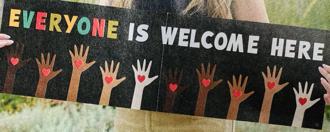
The school district claims it violates the district policy requiring all classroom displays to be content neutral and the state's ban on critical race theory. The teacher end's up resigning and is hired in another district.
We help students learn by making them feel safe. We do that by making sure they know they are all welcome. Sarah Inama
Teacher salaries
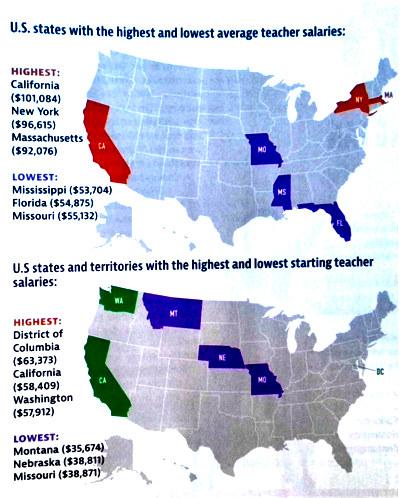
Study finds teacher strikes lead to many positive educational changes.
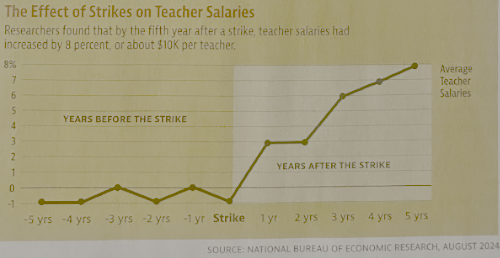
Changes include.
- An average compensation increase of 8 percent, or roughly $10,000 per teacher per year five years after a strike.
- Improved working conditions, with student-teacher ratios decreasing an average or 3.2% and additional per-pupil spending.
- Non-instructional staff, such as social workers and nurses, benefit with an average wage increase of 7%.
Source - National Bureau of Economic Research August 2024
Unions increase pay equity!
The Center for American Progress concludes that collective bargaining has a significant impact on wages and equity.
- Wages: Unions raise wages for their workers. Particularly lower- and middle-income individuals. Since women and People of Color make up the majority of low-wage workers, increased wages help narrow the pay gap for these groups.
- Objective pay standards: Collective bargaining establishes pay based on objective criteria, such as skills and education. It also sets rules to prevent harmful practices-like pay secrecy, which prohibits employees from discussing their wages with co-workers—and creates mechanisms for enforcement of these standards. This reduces opportunities for discrimination and ensures equal pay for equal work.
- Work-life balance: Collective bargaining can secure essential work-life supports-such as paid-leave policies, which can help close the gender pay gap.
Source nea today January 2025
2024
Higher education union membership up!
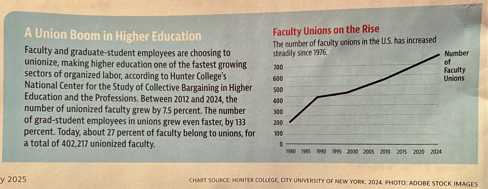
Participatin in sports up
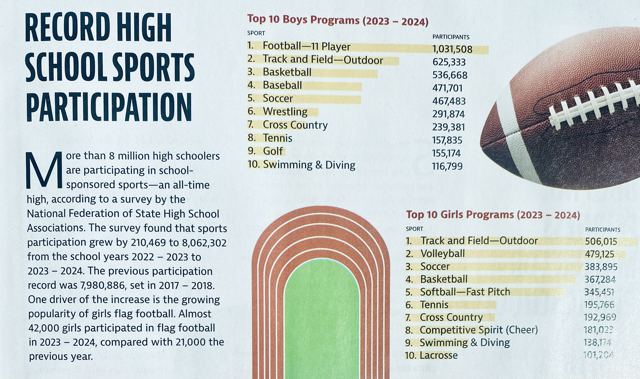
2023 - Campaigns to undermine public schools continue
State of community and public school relationships
About one thousand suburban superintendents are surveyed about their communities and schools relationship.
Their concerns include:
- Contentious school board elections.
- The platform or agenda of at least one school board candidate.
- Increasing contentious school board meetings.
- Attendance at school board meetings has increased noticeably.
- A substantial increase in the number of Freedom of Information Act requests for their district to process.
- They have felt or been threatened and are aware of at least one school board member who has felt or been threatened.
- The spread of inaccurate information related to their schools and/or decision-making processes.
- Potential lack of support for their decisions from parts of the community.
- Being misunderstood and misrepresented.
- The negative affect of current school community relationships on the mental health and physical well-being of their administrators, faculty, and staff.
Source Kappan February 2023
The Heritage Foundation, implores Congress to
dismantle the higher education accreditation cartel by creating alternative - and potentially unaccountable - avenues for financial aid eligibility.
Attacks on accreditation agencies, are designed to destroy academic freedom, college and university autonomy, to serious damage American higher education which provide innovation, excellence, social mobility, and break down barriers to help millions of people achieve their dreams.
Censorship attacks on higher education escalate
Legislative attacks on college and university free speech increase as legislators in state governments introduce hundreds of bills with educational gag orders focused on higher education and dozens of other bills with higher education censorious restrictions, aimed to destroy the integrity and autonomy of educational institutions in favor of state dictates on what content and curricula are appropriate in schools.
2022
Guns become the number one killer of kids and teens in the United States, more than drugs or cancer.
In Carson v. Makin the U.S. Supreme court rules:
if a state offers tuition assistance for students to attend private school, then requiring them to be nonsectarian violates the Free Exercise Clause of the First Amendment. Thus allowing tuition payments to religious schools.
This ruling probably makes any state law or policy that bars religious schools from participating on an equal footing with nonreligious schools in state assistance (vouchers, tuition, charters …) illegal.
This court seems to rule that any state policy that bars religious schools from participating on an equal footing with nonreligious schools for state tuition, vouchers, or any other program, will be sruck down. This raises questions:
If the state denies participation, then
- Is the state protecting against government establishment of religion? Or
- Is the state engaging in anti-religious discrimination?
Justic Stephen Breyer writes: How will the court reconcile their currrent belief that states who subsidize private nonsectarian schools must also subsidize private religious schools?
If the first amendment protects religious entities from having to comply with antidiscimination laws, that conflict with their religion, then how do states, who don't want to support discrimination or religous indoctrination do so?
The answer may be to eliminate all state funding to all private school programs.
The second issue. If a person or entity is allowed to discriminate based on religious beliefs, then much discrimination is permissible? Refusing to bake a cake is one thing, but what about life saving medical procedures?
Education at the start of 2022
Parents report:
- 68% worry about politicians making decisions about curriculum
- 65% worry about child’s happiness and emotional well being
- 63% worry about Child experiencing stress or anxiety
- 60% worry about a family member getting COVID-19
- 57% worry about another school shutdown
- 56% worry about being able to finance child’s college education
- Good news multiple sources show a decline in incidents of bullying
Grief:
- 1 in 14 students lose a parent before they’re 18
- This year 175,000 additional children lost a parent or grandparent to COVID-19
Teachers report:
- 55% will leave or retire early, 1% will work longer, 44% plan no change
- Teachers and the public agree there is a shortage of teachers, support staff, counseling & mental health for staff and students, should be more planning and collaboration time, and better scheduled student holidays to reduce long slogs between breaks.
In Kennedy v. Bremerton School District
the U.S. Supreme court rules that the decision not to rehire a public school's athletic coach, because of his insistence on praying, often with students, at the 50 yard line after games violated the coach's free exercise of free speech rights.
- When does state sponsered religious exercise become coercive?
- When is a school employees personal free exercise, in the presence of students, coercive?
- Does the relationship between the student and school employee or the student's age and experience make a difference?
The majority opinion, led by Neil Gorsuch said: an innocent coach was fired because he briefly and unobtrusively knelt at midfield after a football game to give thanks when students were otherwise unoccupied or left the field. There was no evidence of coercion even though some might have been offended, it was not coercion.
Dissent, led by Sonia Sotomyor said: while he began his prayers alone, overtime most players on the team came to pray, the coach would hold up student helments and speak religious references while players knelt around him, showing coercive pressure. The coach also prayed in the locker room, before being ordered to stop. The case was not about private prayer at work. Is is about: is a school district required to allow an employee to perform a public communicative display of their personl religious beliefs at a school event.
2021
Segregation continues
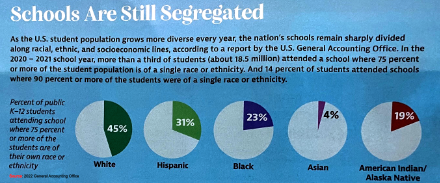
Mask mandates & schools
Lower courts rule for and against mask mandates with a possible push to restore local discretion to make the decision at the local level. Ruling with statements such as ... there is little harm to defendants in leaving a universal mask mandate to local districts discretion. However, studies found schools without mask mandates had 3.5 times more Covid 19 outbreaks.
Some notable rulings:
In Zinman v. Nova Southeastern U. the United States District Court rules against a Florida student’s argument that a mask requirement violates his First Amendment free speech rights by requiring him to express subservience to authority … and … not allowing him to express a message of disapproval for mask mandates by not wearing one. The court ruled against him reasoning … defiance of a law or regulation to communicate disagreement of the law or regulation is insufficient for free speech protection. Otherwise, people could refuse to wear a seatbelt or motorcycle helmet… And he could wear a mask with I hate masks written on it, to express a message of disapproval.
In Resurrection School v. Hertel the 6th. Circuit rules against Catholic school parents and students who challenged Michigan’s law that required all persons 5 years and older to wear a mask indoors, including public and private K-12 schools. The court rejected the claim that wearing a mask violated their right to free exercise of religion by fully taking part in a Catholic education, as masks are uncomfortable and distract from their religious education. The court cited the Supreme Court 1990 decision in Emp. Div. v. Smith to uphold the law as having neutral and general applicability with incidental effect on religion.
In ARC of Iowa v. Reynolds the United States District Court rules that Iowa’s mask mandate ban likely violates federal disability law because it did not make school program services and activities readily accessible to disabled students in the most integrated setting possible, because unmasked conditions are dangerous to children with disabilities or moving them to inferior remote learning, which unnecessarily segregates them from non disabled students.
Campaigns to undermine public schools continue
Public schools depend on their communities to work well. The better the community and tax base the higher the quality of education.
It is the public outcries, about issues such as: critical race theory, ethnic studies, inclusive curriculums, bilingual education, transgender, sex education,and censorship, which are promoted to stroke fears and win elections for candidates who are, anti-public school.
Vouchers is one way to undermine public schools by reducing their resources by moving resources, with vouchers, and other such subsidies by moving critical money from public schools to private schools and corporate schools. Fewer resources along with disrespect for our public schools weaken them and limit opportunities provided our student. Public education money is not only the life blood needed for neighborhood public schools, but healthy schools help maintain their communities economic, social, and entertainment viability.
Five facts often misstated to suport vouchers:
- There is no link between vouchers and gains in student achievement.
- Vouchers lack accountability and enable fraud.
- Vouchers do not reduce the taxes needed to pay for public education.
- Vouchers are rooted in racism and perpetuate discrimination. The Privateers. 2024
- Voucher programs too often fail students with disabilities.
Attacks which are often stated as parental rights, which has a deeply negative historical and shameful context used to segregate children after Brown v. Board of Education.
The strongest anti voucher coalition is rural lawmakers and their constituents.
There is strong social science research that shows investments in public schools have direct short and long term payoff. See The Privateers. by Josh Cowen.
Current attacks used to spread fear about public education.
1.Critical race theory includes explanations for how race is tied to a legal and social system. Such as redlining. Critical race theory is not a curriculum.
- In 2020 Christopher Rufo deliberately initiates attacks on government and education by making absurd distorted claims about CRT. His attacks steadily drive up negative perceptions and turn CRT toxic.
2. History curriculums should include truthful age appropriate stories from diverse backgrounds and cultures.When truthful and age appropriate stories are not told, it is censorship. And when a collective group of ideas is censored, a dishonest form of propoganda is communicated for a political purpose, such as to stoke fear and create injustice, which when acted on results in not learning a full history and does not provide the background and reasoning to confront injustices.
3. Claims of losing freedom, choice, fairness, and liberty to choose what is best for every child. States continue to pass laws for vouchers, freedom of choice, open enrollement, charter schools, home schooling, and on the fly home school pods. All with mixed results for better academic achievement, increased segregation, deminished special education sevices, transfers public tax money to for profit schools, allows citizens with upper incomes to hoard educational opportunities and resources, decreases per pupil spending, reallocates tax expenditures. Reinforced by
4. Deemphasizing the necessity of government to provide education that unifies its country's citizens. And instead emphasizing education as a parental right or responsibility to chose to provide a singular focused education for a profitable career. As if we are consumers shopping for our children's futures. A process which creates mistrust and fear of personal failure to do so successfully. Instead of understanding the public necessity of education as a shared consequence required for a healthy nation.
The dilema
- Parents want their children to be prepared to survive and thrive.
- A state wants citizens that are economically productive and content or complacent as the capital necessary to support and sustain the state.
- Public education was created to achieve these goals.
People will support public schools and the education they provide if they believe: …
What it provides is a legitimate and fair. And the system is equitable in how it determines and educates each person for a social role that each person deserves.
Historically this was achieved by the belief that people were gifted or limited by their birth right and could alter their fortune for better or worse depending on their ability and effort. Thus making what they do or do not achieve deserved.
Today, an equity belief that everyone is capable and deserving focuses cause of success and failure on individual effort, grit, ... and resources available.
To provide success for all, requires a caring inclusive society that is well managed and thriving. One that recognizes the power a diverse population has when they collaborate to solve problems rather than withdrawing into smaller factions who achieve far less.
We achieve this by taking charge through collaboration of our learning and teaching, by recognizing everything humans have achieved. All the good, the bad, and the ugly - in ways that expand our circle of empathy …. from tribes to the whole World and cooperate to achieve Jefferson’s democracy.
Intentionally or not, support of private schools can increase discrimination based on race, color, religion, national origin, ancestry, citizen status, gender, sexual orientation, gender identity, disability, or special education status and divides, rather than unites, us as a country.
See The Privateers. 2024
2020
Covid 19 creates an uncertain school environment. Some challenges include:
- Lack of knowledge on how serious the viral infection is for different ages of people and the consequences of being infected.
- The risks on students and teacher for teaching and learning safely in a different kinds of school environments.
- Lack of initial understanding of the virus, how it is spread, lack of health protocols, and shortages of protective equipment.
- Not knowing if it is possible to have safe face to face instruction.
- How to provide equipment and expertise for everyone or some groups to learn virutally.
- How to help teachers stay healthy and provide support for all changes.
- How to balance public pressure to close schools with the desire to return to school and normalacy.
- Uncertainty with public health recommendations and infection rates.
- Lack of effective and timely testing and tracing.
School attendance increases world wide in the late 1900’s and early 2000’s
While attendance rises achievement remains stubbornly unchanged. Schooling which is successful can be characterized as focusing on personalized adaptive learning to develop every learner’s maximum potential. Including SPED.
Schools remove police from campuses
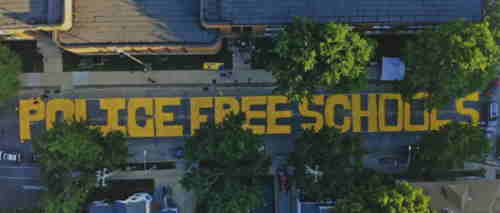
Concerns for better use of resources, than paying to have police officers and SROs in schools, causes actions to replace them and reallocate funding.
School Boards who cancel contracts with the police depatments and remove SROs from their public schools include: Minneapolis Board of Education, St. Paul, MN, Phoenix, AZ, Oakland, CA, with other schools initiating similar actions.
First rulings on transgender
In Bostock v. Clayton County the United States Supreme Court rules discrimination against employees, because they are gay or transgender, violates Title VII of the Civil Rights Act of 1964, the federal employment discrimination law.
Neal Gorsuch writes:
an employer who fires an individual for being homosexual or transgender fires that person for traits or actions it would not have questioned in members of a different sex. Sex plays a necessary and undisguisable role in the decision, exactly what Title VII forbids.
In Adams v. St. Johns County School Board 11th circuit says:
Bostock has great import for [the transgender student's] Title IX claim ... [it] confirmed that workplace discrimination against transgender people is contrary to law. Neither should this discrimination be tolerted in schools. The school board's bathroom policy,as applied to [the student], singled him out for different treatment because of his transgender status.
United States Supreme Court rules vouchers with public funds can be given to private schools as tuition.
In 2018 the Montana Supreme Court rules a recently passed school voucher program has the intent to send money to private religious schools. Which, violates a clause in the Montana Constitution written to prevent public money being given to private religious schools; and struck down the entire program.
The decison is appealed to the United States Supreme Court as Espinoza v. Montana Department of Revenue. The court rules 5-4 that the Montana Supreme Court decision to prohibit voucher funds going to a school controlled in whole or in part by any church, sect, or denomination violated the free exercise clause by prohibiting families from sending children to the religious schools of their choice.
SAT adds an Adversity Score to test reports
College admission decisions are questioned by the public in the media and in court cases. SAT uses 15 factors, related to cultural, social, and economic background, to calculate an additional score (adversity) for test takers.
2019
Schools resources are still affected by a race based history:

- Three out of four neighborhoods redlined on government maps 80 years ago continue to struggle economically.
- Non-White school districts, serving the same number of students, get $23 billion less than White districts.
- For every student enrolled, the average non-White school district gets $2,226 less than a White school district.
- Poor White school districts get about $150 less per student than the national average, but $1,500 more than poor non White school districts.
- In 61 metropolitan areas redlining still persists.
Source: NEA Today October 2019
More historical information: The Color of Law: A Forgotten History of How Our Government Segregated America. by Richard Rothstein.
The Strengthening Career and Technical Education for the 21st Century - (Perkins V) Act is passed and signed into law, replacing the Perkins IV Act of 2006.
The act includes:
- Funds for career exploration and development activities in the middle grades
- Funds for comprehensive guidance and academic counseling in the upper grades.
- Empower states and their stakeholders to determine performance goals.
- Updates and expands the definition of special populations to include homeless individuals, foster youth, and those who have aged out of the foster care system, and youth with a parent who is on active duty in the armed forces.
- Requires yearly reporting on graduation rates, proficiency, placements, with disaggregated performance by gender, race/ethnicity, ability, ELL, income, and more.
- Increases the amount states may spend on students in state correctional systems.
- Increases the amount states may set aside in a special reserve fund to focus on rural areas, areas with high numbers or concentrations of CTE programs, or areas with gaps or disparities in performance. Source
Bethel Ministries v. Salmon
The religious school sues the state of Maryland for with holding state funds for it's anti-LGBTQ policies. It loses, and appeals to the Supreme Court. The school claims it's policies are based on the religious belief: that there are two immutable and complementary genders ... assigned at birth. Therefore, can not be considered a violation of the state's anti discrimination policy, because they don't relate to admissions.
Maryland officials revoked the church school's eligibility to participate in a voucher program to benefit low-income students and demanded the school pay back thousands of dollars for previous participation in the program.
Waiting an appeal decision ...
FUTURE Act passes
It authorizes funds for minority-serving institutions of higher education.
2018
Parkland shooting
On Valentines day, 14 students and 3 staff members are murdered at Marjory Stoneman Douglas High School in Parkland, Florida. Students speak out and spark a national response of outrage and organize to respond to school violence with increased activism across the country.
Court rules Gardendale is not permitted to withdraw from the Jefferson County school district to create a separate school district.
History:
- 1965, eleven years after Brown v. Board of Education. Oscar Adams, sued the Jefferson County Board of Education on behalf of Black school children to end the district’s separate and unequal educational system.
- 1971 the court approves a desegregation order in Stout v. Jefferson County School Board of Education
- Alabama law states, a town with a population more than 5,000 can vote to form its own school district.
- 2012 Glendale, a suburb of Birmingham, AL, seek to follow other White communities and secede from Jefferson County district.
- 2015 a Glendale group petitions the federal court to do so. Other families oppose the petition and sue to remain.
- 2017 The court rejects the initial plan. Claims it would move students to more racially isolated schools, schools with less funds, and communicate inferiority to Black students. However, it did accept a more limited plan.
- 2018 The decision is appealed by both parties. In Stout v. Jefferson County Board of Education the court rules Gardendale is not permitted to withdraw from the Jefferson County school district as the actions were motivated by a discriminatory purpose and hence have no legitimacy at all under our Constitution.
Janus v. AFSCME (American Federation of State, County, and Municipal Employees).
The U.S. Supreme Court strikes down the fair share fees that unions, in 23 states charge non union members to cover their share of cost to bargain and represent them; for which the union is still legally required to represent when bargaining.
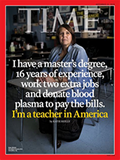
Teacher salaries in U.S. Public Schools
See how much your state's Teachers are underpaid ... yes all states.
Teacher strikes in West Virginia, Kentucky, Oklahoma, Arizona, Colorado
Teachers depressed salaries and low per pupil funding causes teachers to strike for modest increases in wages, health & retirement benefits, and greater per pupil spending.
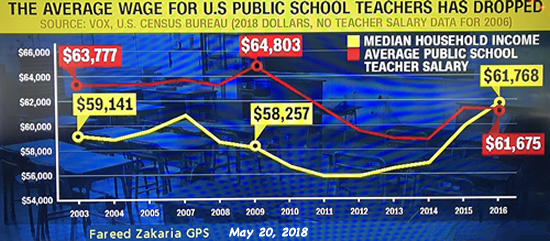
United States Commission on Civil Rights releases a report
The report notes there is still widespread funding inequalities across state education systems that -
"... render the education available to millions of American public school students profoundly unequal." "...low-income students and students of color are often relegated to low-quality school facilities that lack access to teachers, instructional materials, technology support, critical facilities, and physical maintenance." Source
US students are receiving an inadequate education about the role of slavery in American history
Found and reported by The Southern poverty Law Center (SPLC). Teaching hard history: American slavery. SPLC 2018. Atlanta: Georgia.
National Educational Association (NEA) representative assembly pass the following resolution:
“NEA believes that, in order to achieve racial and social justice, educators must acknowledge the existence of White supremacy culture as a primary root cause of institutional racism, structural racism, and White privilege. ... the association will actively advocate for social and educational strategies fostering the eradication of institutional racism and White privilege...“
2017
In Endrew F. v. Douglas County School District the U.S. Supreme Court affirms IDEA’s intent:
... that children with disabilities not only reach minimal standards but make meaningful progress in their education and achieve challenging, individualized objectives.
And sets the standard for an appropriate eduction under IDEA as
... whether the IEP’s substantive educational plan was reasonably calculated to enable a child to make progress appropriate in light of the child’s circumstances.
In Trinity Lutheran Church of Columbia, Inc. v. Comer
The Supreme Court of the U.S. rules that denying public grant money to the church's preschool and daycare center discriminated against them solely because of their religious character.
Over rules Everson …
Sotomayor and Ginsberg dissent that government funds will be used to
... fund improvements to the facilities the Church uses to practice and spread its religious views.
2016
We Will Rise. Michelle Obama's Mission to Educate Girls Around the World.
The First Lady, Meryl Streep, Freida Pinto and CNN's Isha Sesay take a journey to Morocco and Liberia, where they meet young women overcoming incredible odds to change their lives.
Video, We Will Rise. (1 hour) may need to login through cable provider for CNN.
Additional information
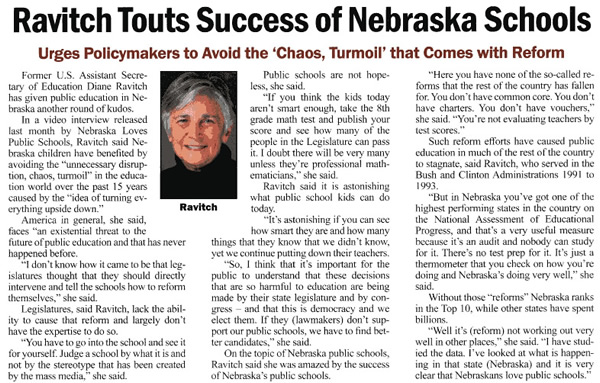
Andrew F. v. Douglas County
The Supreme Court rules a student [child with disabilities] offered an educational program providing merely more than de minims progress from year to year can hardly be said to have been offered an education at all.
his moves the achievement level higher than what is set in the 1982 ruling in Board of Education v. Rowley.
2015
Washington State Court Rules Against Charters
In September 2015 the court rules, charter schools violate the state's constitution and overturn a 2012 law, which allows public tax money to be used to fund private schools. The ruling contends:
- The constitution requires the legislature to provide a general and uniform public school system.
- The entire revenue from the common school fund and state taxes shall be exclusively used for the common school.
- Common schools defined as schools that are common to all children of proper age and capacity, free, and subject to and under the control of the qualified voters of the school district.
- Charter schools do not qualify as common schools and can not receive public tax dollars.
- Washington's charter schools are not governed by locally elected boards, lack democratic transparency and accountability since they are managed by private organizations that appoint their own boards.
Kindergarten & school attendance requirements - 2015
- 34 states require school districts to provide ½ day kindergarten
- 11 states plus D.C. require full day kindergarten: 11
- 5 states (Alaska, Idaho, New York, Pennsylvania, New Jersey [only Abbott districts must] do not require districts to offer kindergarten.
- 15 states plus D.C. require children to attend kindergarten (35 do not)
- The most common birth date by which children must turn 5 to be eligible to enroll in kindergarten is September 1 (19 states). Other sates birth date cut-off ranges from as early as July 31 (Hawaii, Missouri, Nebraska, North Dakota) to as late as January 1 (Connecticut).
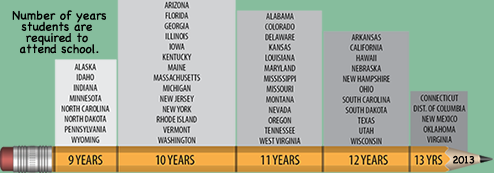
Reauthorization of the Elementary and Secondary Education Act of 1965 (ESEA)
Every Student Succeeds Act (ESSA)
- Prohibits the federal government from acting as a national school board. Clearly the intent is deny the U.S. Department of Education the power to compel states to adopt favored standards, policy, or any other school related ideas.
- Advances equity by upholding critical protections for America's disadvantaged and high-need students.
- Requires—for the first time—that all students in America be taught to high academic standards that will prepare them to succeed in college and careers. Through significant opportunities to receive a fair, equitable, and high-quality education, and to lose educational achievement gaps.
- Ensures that vital information is provided to educators, families, students, and communities through annual statewide assessments that measure students' progress toward those high standards.
- Helps to support and grow local innovations—including evidence-based and place-based interventions developed by local leaders and educators—consistent with our Investing in Innovation and Promise Neighborhoods
- Sustains and expands this administration's historic investments in increasing access to high-quality preschool.
- Maintains an expectation that there will be accountability and action to effect positive change in our lowest-performing schools, where groups of students are not making progress, and where graduation rates are low over extended periods of time.
The National Educational Association (NEA) representative assembly adopts the following:
... we the members of the National Education Association, acknowledge the existence in our country of institutional racism - the societal patterns and practices that have the net effect of imposing oppressive conditions and denying rights, opportunity, and equality based upon race.
2013
The U.S. Supreme Court refuses to hear the B.H.& K.M. v. Easton Area School District case, upholding the lower courts ruling that wearing rubber bracelets with the phrase "I ♥ Boobies! (Keep A Breast)" may be protected by the First Amendment right to free speech.
On Breast Awareness Day two middle school students are asked to remove their bracelets, they refuse and are punished by being denied to attend extra-curricular activities. The court is informed by the fact: “there were no incidents presented to the Court of any disruption prior to the School’s bracelet ban.”
Summary of professional educator role changes entering twenty-first century
- From each teacher finding their own teaching style to teaching being defined by a professional community or board,
- From teaching as dispensing information to teaching as facilitating student's construction of knowledge and learning how to learn,
- From teaching as technical work to inquiry with authentic instruction,
- From controlling student behavior to being accountable for student performance,
- From teachers being managed to teachers as leaders,
- From learning taking place in the classroom to learning in the world community,
- From an undefined knowledge base to a rigorous and broadly defined common core knowledge base for students connected to a teacher's knowledge base on creating curriculum, instruction, and assessment.
Along with new additional ideas like:
- Teacher's beliefs and experiences affect what they teach.
- Knowledge of children and adolescents is crucial for teaching and student understanding.
- Teachers need opportunities to plan, reflect, and analyze to improve their teaching and student learning.
2009
Common Core State Standards adopted by 43 states
The National Governors Association and Council of Chief State School Officers, funded in part by the gates foundation support the writing of the Common Core State Standards. They are concepts and outcomes students should know and be able to do in math and language arts from Kindergarten to hight school to prepare students for college and careers and make them more competitive academically. Source
2008
Congress amends FERPA (created to protect student privacy) to create a school official exemption
However, a loopholw is created so that whenever a teacher or other school official gives a technological provider consent, the company acquires a treasure trove of data analytics to use without parent consent. While information must be de-identified to be legally used for predictive analytics. It is fairly easy to re-identify students.
Further, because the companies who acquire the data are private, they can not be required to provide public record requests.
2007
Supreme Court rules schools have authority to censor student speech that promotes illegal drug use, at school events in Morse v. Frederick
At a school sponsored event, Joseph Frederick displayed a 14 foot banner with "Bong Hits 4 Jesus." during the Olympic torch run through their community. The principal Deborah Morse took away the banner and suspended Frederick for ten days. She used the school policy against the display of material that promotes the use of illegal drugs as justification. Frederick challenged the action on the basis of his right to free speech that was not disruptive. See Tinker v. Des Moines Ind. School District 1969. The US. Supreme Court rules (5-4) that students do have some right to political speech, however, schools may restrict student speech at school sponsored events if the speech promotes illegal drug use.
Supreme Court rules integration plan violates equal protection in Parents Involved in Community Schools v. Seattle School District No 1.
The Seattle School District has an open enrollment policy to resolve segregation and maintain racial diversity. Parents sue on the basis of race being contrary to the Equal Protection clause.
The U.S. Supreme Court stops their voluntary integration plan by claiming school officials could only consider race to assign students to schools if there is a compelling interest to remedy past intentional discrimination. Further, the court claims the district did not present a compelling state interest for the use of race in their diversity plan to achieve specific educational benefits sufficient to achieve a compelling state interest.
It seems the court failed or was unwilling to consider: segregation today is a result of private choices, which have historically been limited by long imposed discriminatory decisions based on social status and racial heritage.
2005
Selman et al. v. Cobb County School District et al.
Court rules that requiring an evolution warning label on textbooks violates the Establishment Clause of the First Amendment. See 2000
Kitzmiller et al. v. Dover
The U.S. District Court orders the Dover Area School Board not to include the implementation of their Intelligent Design Policy in any schools in the district. The court rules the policy violates the First Amendments Establishment Clause and the teaching of intelligent design in public schools is unconstitutional. See 2000
A challenge to the teaching of evolution: has been tried over and over again: changing from a direct challenge of evolution, then creation science, followed by intellectual design, critical analysis, freedom of speech, academic freedom. … and most likely more to come. Future rulings will depend on the appointment of judges.
When cases specifically target teaching related to evolution, one needs to ask why it is necessary? The only answer can be to promote a religious doctrine over another.
2004
Individuals with Disabilities Education Act (IDEA) is reauthorized again.
School personnel are given more authority for special education placement and better alignment with the No Child Left Behind Act.
Supreme Court rules to retain under god in the Pledge of Allegiance
Elk Grove Unified School District v. Newdow. Michael Newdow claims having his daughter recite under god in the pledge violates the first amendment establishment clause. The court rules recitation of the Pledge in school did not. See 1943
Hearn & U.S. v. Muskogee Public School District
District court and the Justice Department determine Nashala’s decision to wear a headscarf is protected by the Constitution's guarantee of equal protection and religious freedom. Source
Perkins act reauthorized
Reported to Senate recommends to reauthorize and amend the Perkins Act of 1998. While the report finds there is a disproportionate representation of students, particularly gender, in the programs it doesn’t include any significant goals on equity or nondiscrimination.
The Act is renamed as the Carl D. Perkins Career and Technical Education Improvement Act of 2004.
2003
Affirmative action, quotas, and race
On June 23, 2003, the Supreme Court abrogated Hopwood in Grutter v. Bollinger the U.S. Supreme court rules the United States Constitution does not prohibit the law school's narrow use of race in admissions decisions to further a compelling interest in obtaining a diverse student body. The ruling means that universities in the Fifth Circuit's jurisdiction can again use race as a factor in admissions (as long as quotas are not used as in Gratz v. Bollinger (2003). Source
Supreme court rules entrance based narrowly on race unconstitutional in Gratz v. Bollinger
Two White students are denied entry into the University of Michigan’s undergraduate College of Literature, Science, and the Arts, and file suit against their advisor. They claim that the admission policy violates the 14th Amendment’s Equal Protection clause. The U.S. Supreme court rules the policy is unconstitutional under the Equal Protection Clause of the 14th Amendment since it gives automatic preference to minority students on the basis of race.
2003, 2001, 1999, & 1997
Standardized tests, SAT, as biased admission criteria
Pryor and Spivey (2003) appeal to the Third Circuit Court It rules there is a sufficient claim for purposeful discrimination under Title VI. However, it also rules the claim did not hold, because Alexander v. Sandoval ruling prevents Title VI from being used by private action.
Alexander v. Sandoval (2001) United States Supreme Court decision held a regulation enacted under Title VI of the Civil Rights Act of 1964 did not include a private right of action to allow private lawsuits based on evidence of disparate impact (meaning it may be considered discriminatory if it has a disproportionate adverse impact against any group based on race, national origin, color, religion, sex, familial status, or disability). Thus, making it difficult for private citizens to sue public entities, by requiring they prove intentional discrimination.
Pryor v. NCAA (1999), Kelly Pryor and Warren Spivey were offered athletic scholarships in 1999. However, neither student was able to meet Proposition 16 guidelines. The Third District Court ruled in favor of the NCAA, but said it could be possible to bring successful purposeful discrimination suits against the NCAA. Pryor and Spivey argued the NCAA knew Black athletes would receive fewer scholarship. The NCAA stated their intentions were to increase Black athletes graduation rates and not to discriminate against any athlete. District court ruled in favor of NCAA and no intentional discrimination.
Cureton v. NCAA (1997), Black student-athletes who met the NCAA grade point average requirement but not minimum SAT score. The district court rules Proposition 16 had a disparate impact on African-American students and violated Title VI. However, the Third Circuit Court reversed the decision. Stating, Title VI only applied to programs or activities using federal funds and since the NCAA does not directly admit students, Title VI does not apply. Furthermore, the Alexander v. Sandoval decision states Title VI only covers intentional discrimination and NCAA argued it wasn't intentional, but trying to insure greater success of athletes.
Summary:
- These cases demonstrate legal actions can create social pressure for change if court decisions do not demand it.
- Institutions should be wary if they use entrance exams. They should carefully evaluate their admission requirements and be prepared to justify possible effects on graduation rates of their applicant pools. Source
2002
No Child Left Behind (NCLB), increases the federal role in public education. It does not provide national standards, but requires states to develop or adopt their own standards. It focuses on accountability through state-mandated standardized testing and punishment to improve schools and ultimately the education of our youth. Based on the belief data driven decision making (DDDM) should diagnose student needs, implement target support based on data that informs curriculum will improve schools and student achievement.
States are required to use their designated standards and create a system that uses standardized annual testing to collect multiple measures to determine if adequate yearly progress (AYP) is met and report this information to the public and government officials for the evaluative purpose of rewarding and punishing schools through Title 1 funding and corrective measures. States are also required to determine what makes a highly qualified teacher.
Corrective measures:
- Schools that miss AYP two consecutive years are publicly labeled as in need of improvement and must develop a two-year improvement plan. Their students were permitted to transfer to a better school in the district, if one exists.
- If AYP is not met the third year, they must provide free tutoring and additional support services for students.
- If AYP is not met a fourth consecutive year, they are required to take corrective action, which can be replacement of all staff, introduction of a new curriculum, increase class time for students.
- After a fifth consecutive year, they must develop a plan to restructure the entire school. The plan must be implemented if AYP is not achieved in the sixth year. restructure plans can be to close the school, turn it into a charter school, hire a private company to run the school, or have the state take it over.
Supreme Court rules state vouchers can be paid to religious schools.
Zelman v. Simmons- Harris Ohio enacts a tuition voucher in Cleveland City Schools for students to use in religious and secular private schools. Ohio taxpayers challenged it as a violation of the Establishment Clause. The court rules vouchers are neutral in terms of religion, because children and families, rather than schools, benefit, therefore, did not violate the Establishment Clause.
Supreme Court rules drug testing of students in extracurricular activities legal.
Board of Indian school District #92 of Pottawatomie County v. Earls the district required urinalysis to participate in extra curricular activities. Earls challenged the policy as a violation of students' Fourth Amendment rights to privacy. Court ruled in favor of the District noting the testing was done in a minimally intrusive manner and consistent with the interest of deterring drug use. This builds on Vernonia School District v. Acton 1995 allowing testing of student athletes.
2001
U.S. Supreme Court rules that a school board's mandatory school uniform policy did not violate the First Amendment rights of its students
Canady v. Bossier Parish School Board. In the 1998-1999 school year, the school board implements a mandatory school uniform policy. Parents challenged the new dress code on First Amendment grounds. The Fifth district court ruled dress could be a form of expression protected by the first amendment. However, a uniform policy could be upheld if it supports an important or substantial government interest, an interest unrelated to the suppression of student expression, restrictions to speech were no more than necessary to further the state interest, and it was not meant to curtail any particular viewpoint or message. The court ruled the policy did not.
2000
The Children’s Online Privacy Protection act (COPPA) goes into effect
It is not enforced enough to make a difference.
Rodney LeVake v Independent School District 656, et al.
Minnesota State District Court dismiss the case brought by the school district against a high school biology teacher who argued he had the right to teach evidence both for and against the theory of evolution. The court rules the school district considered the content of what he was teaching did not match the curriculum, which requires the teaching of evolution. Therefore, he does not have a free speech right to override the curriculum. See also 1997 & 2005
Santa Fe Independent School District v. Doe
The U.S. supreme Court held student initiated prayer at public school football games violated separation of church and state principles under the First Amendment's Establishment Clause.
Decision based on: use of the school's public address system, speaker represented the student body, supervision of school faculty, and a schol policy that encourages or coerces those present to participate in an act of religious worship through public prayer.
Summary of ideas that influenced the Twentieth Century
Political ideas in the 1920's... that influenced educators and the public who made educational decisions were: free public education for all, compulsory education, elementary school goals and objects with a focus on literacy through the subjects of reading, writing, arithmetic and disciplined study to ready students for a more rigorous secondary education. Secondary school goals and objectives were oriented toward college prep for the able, vocational studies for the less able, and preparation for everyone to become productive obedient citizens. Taught by certified teachers, using direct instruction methodologies in group settings and a subject centered curriculum. Quality education was subsidized by women who were limited by lack of professional job opportunities in other areas of employment. This increased the number and quality of professional educators while it depressed wages and reduced taxes. This began to change as employment opportunities opened to women after the mid 1900's.
Educational ideas in the 1920's that influenced education:
- Information was packaged in subjects, measured with Carnegie Units, in a seven and eight period day, over an average 180 day school year. Information was delivered through lecture and textbooks and assessed with standardized tests which were largely multiple choice.
Information At the beginning of the century the Committee of Ten standardized information by subjects and somewhat delineated relevant content they important. At the other end of the century professional organizations for different subjects gathered and wrote standards for content, teaching, and administration based on their particular subjects. P21 Partnership for 21st Century Learning wrote standards that included life learning skills. Information selected and described by all these committees some consider ideological or dogmatic. A large segment of the general public believe it is sufficient that content be limited to a collection of common facts necessary to be job ready at graduation. They chide a liberal education that is open to investigation that encourages problem solving and critical thinking about big ideas through alternate paths of study that often culminates in uncertainty and skepticism with the discovery of multiple possibilities. This liberal or progressive education is often coupled with student interest met with student empowerment and choice, which many people believe will result in students making poor choices and not working hard enough to achieve a high quality elite education. Openness allows for many entry points of learning, makes room for different voices, is the best guarantee to discover and fixes errors so children and adolescents learn better and educators learn how to make education better. Learning, education and schooling are always works in progress. - Mandatory education for all children and adolescents of a certain age increased the number of students. This created a need for an increase in the total number of schools or for each school to be larger to meet the demand of the increasing enrollment.
- Education for all. In the twentieth century the idea of a public education for all, equal access, school choice, and the idea all students can learn became stronger as the century unfolded. Toward the beginning of the century, 1918, compulsory education laws existed in all states. However, few people believed all really meant all children. Women, non-White, handicapped, ability, poor, and LBGTQ ( lesbian, gay, bisexual, transgender, and questionable people) were mostly thought to be less able or worthy of a high quality education. These changes were influenced by greater acceptance of a more broad definition of all. Events such as in 1920 women were granted the right to vote, 1954 with Brown vs. Board of Education affect on segregation amid separate and equal, 1928 restructure of Native American education, 1969 and later laws for children with learning disabilities, and 1965 Elementary and Secondary Education Act and Title 1 to address socio-economic limitations. ...
- Limited resources created a desire to find economical and efficient solutions. A simple solution was to put greater numbers of students in schools and increase class sizes. As crowding increased larger building were built and benefited by having greater resources in a common location. This lead to thinking of consolidation of school districts as more efficient and economical. Specialization of teachers in the upper grades. Instead of increasing school districts more and more states choose to consolidate school boards into bigger districts decreasing the number of independent school districts in the U.S.
1920 - 200 000+; 1952 - 67 000; 1982 - 14 851; 2012 - 12 880; Source
This decrease in school boards and districts had a significant detrimental effect of reducing the number of school board members. Community leaders who had a vested personal involvement dedicated to know what was happening in their schools to make decisions that would best benefit their students in a democratic manner. For example: if there were 200 000+ school boards in 1920 with an average of 8 members per board, that would be 1.6 million board members. In 2012 if there were12 880, then that would be about 100 000. That is a significant difference that would seem to have a large effect on people's positive involvement in education. Further, if the increase in population from 1920 to today was considered, then the increase of the number of people that each board member represents is even more detrimental to school community relations. - Governance. As schools and districts grew so did concerns of governance, quality of instruction, standardization, evaluation, and accountability of teaching and learning. Hierarchal bureaucracies were created, similar to military and factory organizations to address these concerns, too often, with the belief they could be managed with rewards (merit pay, grading, scholarships, ...) and punishment (school closure, expulsion, firing teachers...). Thinking of learning as production on an assembly line factory managed with efficient spending of resources and effective instructional methods to achieve a quality standardized education. Creation of instructional methodologies (mastery learning, directed instruction, cooperative learning, learning cycle ...), effective instructional strategies, teacher proof curriculum, scripted teaching, standardized uniform curriculum, ...
Control of schools moves from teacher and boards of education to state and national government. With more rules and regulations being imposed top down in the name of accountability and standardization with high stakes standardized tests used to rate students and schools. Eliminating local control and personal choice and empowerment of students and teachers, parents and communities. - Validation of organizational patterns and instructional methodologies being substantiated with information analyzed through scientific and statistical means. Standardized testing to sort students and validate achievement, teacher assessment, teacher training with the teacher in a scripted role of technocrat. Required entry level testing, certification testing, teacher observation, peer evaluation... All based on the assumption that if one can define it, then it can be measured.
- Good teachers - Review 100 years of what mades good teachers and how they were assessed. Good teachers, Plural, by Donald R Cruickshand & Donald Haefele in Ed Leadership, 2001.
- Professionalization Teachers as professionals is advocated. As teachers see value in meeting and sharing ideas, to increase the quality of their teaching and the quality of education for their students, they create The National Education Association (NEA) and American Federation of Teachers (AFT). WIthin these organizations various ideas to achieve these goals are explored. Ideas such as: all employees should have the guaranteed right to join a union and have a voice on their job. Collective bargaining and strikes to negotiate with state and local school boards over better working conditions and an equitable wage. Due process and job protection from irrational dismissal. These organizations become most important, as many studies suggest, for self-governance and teacher autonomy, than getting higher wages. Important for not only empowering teachers as professionals, but to create environments were students see self-governance in action so they may learn that democracies can be messy, but they can also work. Research will strongly suggest collective bargaining rights strengthen the organization they represent along with their entire community, and protect our democracy.
More resources:
Twentieth century
1999
Columbine High School shooting
In Columbine, Colorado two high school students murder 12 students and one teacher on April 20. It becomes, at the time, the worst school shooting in U.S. history and prompts significant changes to insure safe school environments. Safety changes like: visitor sign in, locks on classroom doors, locked doors, intruder drills, armed guards, metal detectors, fencing, barriers, ... which change the school experience for all students.
Olmstead v. L.C.
The U.S. Supreme Court rules the institutionalization of people with disabilities amounts to a discriminatory and unjust form of segregation, in violation of Title II of the Americans with Disabilities Act.
1998
Wisconsin Supreme Court rules the City of Milwaukee can use tax money to pay tuition for pupils to parochial or other religious schools. The court says the program ''has a secular purpose'' and ''will not have the primary effect of advancing religion.''
1997
Reauthorization of the Individuals with Disabilities Education Act (IDEA)
Changes include:
- Adding regular education teachers to the IEP process
- Providing students more access to the general curriculum.
- Include students in state-wide assessments
- Add ADHD to the list of conditions for eligibility of services under the category, other health impairment.
Freiler v. Tangipahoa Parish Board of Education
The U.S. District Court for the Eastern District of Louisiana rejects a policy requiring teachers to read aloud a disclaimer when teaching evolution. Ruled intelligent design equivalent to creation science and the school board was endorsing a religion that is counter to other religious views with the disclaimer. In 2000 the U.S. Supreme Court declines to hear the School Board's appeal. See also 1994 & 2000
1996
Successful challenge to university affirmative action policy in student admissions in Hopwood v. Texas
Four White students who are rejected admission to University of Texas at Austin's School of Law despite having better combined LSAT and grade scores than 36 of the 43 Latinos admitted, and 16 of the 18 Black students admitted challenge the school's admissions policy on equal protection grounds.
Seven years the Hopwood decision is abrogated by the U.S. Supreme Court in 2003.
Regents of the University of California v. Bakke, 438 U.S. 265 (1978).
US. Department of Education urges schools to adopt uniforms as a strategy to reduce school violence. It claims to:
- Decrease violence and theft.
- Prevent gang members from wearing gang colors and signs at school.
- Help students learn to be more disciplined.
- Resist peer pressure.
- Identify non students that might be in school.
Brain and emotion
The Emotional Brain, written by Joseph E. LeDoux, an American neuroscientist, may be a landmark for greater acceptance of how little control people have over their emotional reactions and the power of emotions as motivators for the decisions we make. Especially brain and endocrine mechanisms related to memory, pleasure, love, anger, fear, anxiety, and addiction.
Report: What Matters Most: Teaching and America's Future, by the National Commission on Teaching and America's Future, 1996.
Suggested:
- Standards for teaching
- Connecting teacher standards to student standards
- Higher requirements for teacher licensure and renewal
- Rigorous testing of teacher knowledge
- Overhaul preservice teacher preparation programs and close program that don't meet national standards.
- Incentives and rewards for star teachers
- Peer assistance to help teachers needing improvement
- Dismissal of teachers not meeting standards
- Improved working and learning environments for teachers and students.
1995
Vernonia School District v. Acton 1995 rules in favor of allowing drug testing of student athletes.
Opponents of bilingual education file lawsuits against school districts to stop bilingual education fail.
Bushwick Parents Organization v. Mills in New York claim that for ELL students to have the same educational opportunities as all other students they need to have the same opportunities as other students, not the different experiences provided ELL students. Additonal attempts also fail. Source
Early 1990's. Home schooling is legal in all fifty states with the help of the Home School Legal Defense Association HSLDA.
1992
Lee v. Weisman U.S. supreme Court rules the government may not coerce anyone to support or participate in religion or it exercise.
Claims students have: "no real alterntive which [allow them] to avoid the fact or appearance of participation [in an] overt religious exercise in a secondary school environment."
Freeman v. Pitts
Makes it easier to get dsegregation orders rescinded.
1990
The Milwaukee School Voucher Program is passed.
The Milwaukee Parental Choice Program provides public funds for low income students, in Milwaukee, to pay their tuition to private schools. It is the largest such program in the United States.
Wendy Kopp, founds Teach for America
Individuals with Disabilities Education Act (IDEA) 1990.
PL 94-142 is renamed to Individuals with Disabilities Education Act (IDEA) .
- The document replaces the term, disability, with, handicap.
- Requires transition services for students.
- Adds autism and traumatic brain injury to the eligibility list.
- Congress is still underfunding services to special needs individuals by more than half of what is promised in 1975 PL 94-142.
1988
The U. S. Educational Partnership Act passes
It is to encourage the creation of alliances between public elementary and secondary schools or institutions of higher education and representatives of the private sector in order to apply the resources of the private and nonprofit sectors of the community to the needs of the elementary and secondary schools.
Charter schools presented by
Albert Shanker, president of the American Federation of Teachers articulated a vision of a school where students would be diverse culturally, racially, and socioeconomically. Were teachers would collaborate and experiment with fresh innovative pedagogical approaches and curriculum. Where what they learned would be shared with traditional schools to improve them.
In his vision these schools were administratively included within current education schools districts or systems. He believed in democracy and the importance of students seeing it modeled first hand in their classes and by seeing teachers as active participants in the decision making of the charter school. He also believed unions played a critical role in democratic societies and wanted charter schools unionized.
His ideas were sparked with a visit to a school in Cologne, Germany, which was very unlike the traditional tightly tracked German schools. This school had teams of teachers who had considerable input in how the school was run and were empowered to make pedagogical decisions and curriculum choices. Teachers stayed with a class of students for six years. Students were of mixed abilities, family incomes and ethnic origins. Immigrants were educated alongside native students in mixed-ability groups. Resulting in 60% doing well enough to be admitted to a four-year college. This can be compared to 27% of students nationally.
See New York Times: The Original Charter School Vision for additional information.
1987
National Certification
The National Board for Professional Teaching Standards offers national certification for accomplished teachers.
Edwards v. Aguillard
The U.S. Supreme Court held Louisiana's Creationism Act unconstitutional since it lacks a clear secular purpose, endorses religion, and undermines science teaching when creation science is included as evolutionary science. See 1982 & 1994
New Jersey is the first state to take over a school district. 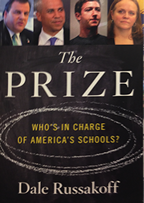
New Jersey passes legislation in 1987 authorizing the state’s takeover of Jersey City schools the following year. The state goes on to take over operations of the:
- 1991 - Paterson schools
- 1995 - Newark public schools
- 2013 - Camden public schools
For a story of Newark's schools from 1995-2014 see The Prize by Dale Russakaoff. She does an excellent job of presenting an unbiased narrative of Newark's dilemma of how to improve failing schools in a dysfunctional educational and political culture. The complexities of building an education system based on corporate culture, profit, loss, incentives, bonuses, merit pay, closures, and firings. The prize - Newark's billion dollar budget. Where the only winners seem to be students who have parents who are able to negotiate a school system maze and enroll their child in a winning school. To achieve good schools where all students might be successful in Charters and Public Schools she concludes both must operate within a community where parents are involved, that medical and mental health services are available, community jobs or services overcome poverty, trauma, and neglect and students needs and interests are met. Will Newark become the charter school capital of the nation?
1986
Connecticut’s Education Enhancement Act
After studing low performance in K-12 schools. Connecticut decides the best way to achieve its reform objectives is by raising teaching standards. Standards for teacher preparation, certification, induction, and career development which are enacted through the Education Enhancement Act. It will be highly successful in the coming years.
A Nation Prepared: Teachers for the 21st Century, Carnegie Report
Claims a professionalized teaching force based on a new system of high standards is necessary for student success. A system with high academic achievement standards for students and high standards for teachers in curriculum, instruction, and assessment. Standards created and implemented by a national board of teachers who would be seen as leaders of the profession. When this is put in place, it claims students would succeed.
Court rules (7-2) student speech may be restricted if it interferes with the educational process in Bethel School District v. Fraser.
Matthew Fraser, a students at a High School assembly, gives a nomination speech for a classmate which includes what some think is graphic and sexual in nature. Matt is suspended three days. The court agreed political speech was protected, but vulgar and lewd speech was not since it was not within the fundamental values of public school education. Upholding his suspension.
In 2007 Chief Justice John Roberts says, "The mode of analysis employed in Fraser is not entirely clear." Chief Justice Burger claims fraser's speech isn't political, yet it is given at a school sponsored event for the purpose of the election of student government and advocated for one of the candidates. The claim it is sexually explicit and graphic is not accurate as he implied sexual references and innuendo similar to TV comedies and PG13 rated movies at the time. Finally, it did not include any standard for assessing a school officials' actions for restricting speech.
1985
Accountability, Back to the Basics, and Standards, 1985.
- Total Quality Education (TQE) born from Total Quality Management (TQM) who W. E. Demings and others wrote and lectured that: frequent monitoring of a processes is necessary to achieve a quality desired outcome. Not really strong as total curriculum.
- Outcome-Based Education (OBE) a process to define goals, specific classroom behaviors, and outcomes with emphasis on outcomes. William Spady based it on 1. clarity of focus, 2. top down design, 3. high expectations, and 4. expanded opportunity.
- Performance Based Education,
- Standards based education. While standards were being worked on the real impact was more 1990 and beyond. Standards
- High Performance Learning,
- Transformational Education,
- Competency-Based Education
First open enrollment law is passed in Minnesota, 1985.
In 1989 Arkansas, Iowa, Nebraska, and Ohio, pass open enrollment legislation and in 1990 Idaho, Utah, and Washington do.
Open enrollment may be voluntary or mandatory at a state or district level, and may allow intra district or inter district transfer.
- Voluntary allows individual schools or districts to decide whether they will accept students who live outside their boundaries.
- Mandatory requires all districts to provide the option and accept student requests, although a policy can be restricted by opt-out provisions, priorities , or desegregation provisions within different laws.
- Intra district policies allow student admission to a school outside their assigned district.
- Inter district policies allow student to attend schools across district boundaries as well as within districts.
Supreme Court rules the Fourth Amendment’s more lenient standard of reasonable suspicion may replace the ordinary standard of probable cause.
New Jersey v. T.L.O. A student is caught smoking, teacher searches her purse, finds cigarettes and marijuana. The student is suspended three days for smoking cigarettes in a nonsmoking area and seven days for possession of marijuana. A lower court ruled her Fourth Amendment rights were violate. However, the Supreme court overturned the ruling and says. A search will be permissible when it is reasonably related to the objectives of the search and not excessively intrusive in light of the age and sex of the student and the nature of the infraction.
In dissent Justice Stevens wrote.
“The schoolroom is the first opportunity most citizens have to experience the power of government, Through it passes every citizen and public official, from schoolteachers to policemen and prison guards. The values they learn there, they take with them in life.”
Transforming public schools into Constitutional free zones would harm the nation as a whole by distorting the relationship between citizens and their government as today’s students become tomorrow’s adults, they risk bringing with them impoverished understandings of constitutional protections.
1984
Carl D Perkins Vocational Education Act passes
Ensure all students, especially disadvantaged have access to quality vocational education programs. See 2004, 2019
1983
The Reagan administration urges schools to partner with corporations to increase funding.
Opens the door to commercialization of public schools and some believe influences schools for profit. See 1929
Multiple Intelligences. 1983
Howard Gardner published, Frames of Mind: The Theory of Multiple Intelligences. Where he introduced and described eight intelligences.
Description of the first eight and one more he added later
In 1985 Sternberg suggested three fundamental kinds of intelligence: analytic, creative, and practical. These ideas can be used to describe authentic learning. They may also be applied to describe how each of the eight intelligences can be applied analytically, creatively, and practically.
A Nation at Risk: The Imperative for Educational Reform, published by the National Commission on Excellence in Education. 1983.
Claimed American schools were failing and suggested ideas for improvement:
- Greater accountability in terms of student achievement
- Standardization
- Standardized testing
- More empirical knowledge
- Greater time for science, mathematics and technology
- Longer school days, longer school year, and more homework
- Higher graduation requirements
Two quotes most often reported:
...the educational foundations of our society are presently being eroded by a rising tide of mediocrity that threatens our very future as a Nation and a people..
If an unfriendly foreign power had attempted to impose on America the mediocre educational performance that exists today, we might well have viewed it as an act of war.
1982
U. S. Supreme Court rules denying children an education because of their parent's status is not in any state's interest.
Plyler v. Doe State law allowes local school districts to refuse to pay for undocumented students and children of undocumented parents. Thus the Plyler School district charged tuition for said students and a case was filed on behalf of these students.
The Supreme Court rules the Fourteenth Amendment of the U.S. Constitution, gives all persons equal protection of the laws and to deny them the ability to live within the structure of our civic institutions, would not allow them to contribute in even the smallest way to the progress of our Nation. Additionally the Court said, holding children accountable for their parents’ actions does not comport with fundamental conceptions of justice.”
U. S. Supreme Court rules there must be a legitimate pedagogical concern to remove books (censor)
In Board of Education of Island Trees School District v. Pico the board of education over rules the recommendations of the school and community and removes the books: Slaughter House Five, Go Ask Alice, and Black Boy from the middle and high school libraries. The Supreme Court rules the board did not have the right to remove books, because they disagree with their content.
However, the ruling doesn't make a clear distinction of the conditions for book removal or retention.
The ruling also includes these additional remarks.
- Schools may remove library books because they are pervasively vulgar or aren’t age-appropriate or educationally suitable.
- School libraries are places where students must always remain free to inquire, to study and to evaluate, to gain new maturity and understanding. Justice Brennan
- In dissent Justice Rehnquist says ... elementary and secondary school libraries are not designed for free wheeling inquiry; they are tailored, as the public school curriculum is tailored … a place for the selective conveyance of ideas.
- Multiple judges objected to the idea that a right to receive ideas exists at all. Asking. What would be the limits?
- Justice O’Connor states. … it is not the function of the courts to make the decisions that have been properly relegated to the elected members of school boards.
- A year later in the Perry Educators’ Association case expands with … a school board may not act with an intent to discourage one viewpoint and advance another.
Future cases in lower courts rule:
- 1995 Case v. United School District rules removal of Annie on My Mind, about a romantic relationship between two teenage girls, denies students access to ideas with which they disagree is in violation of the First Amendment and Pico
- 2003 Counts v. Cedarville School District rules restricting the book Harry Potter would violate the First Amendment: …
- 2009 ACLU v. Miami-Dade County School Board Rules rremoval of Vamos a Cuba! is appropriate because it contains untruthful statements and a life in Cuba that does not exist.
Board of Education v. Rowley
The Supreme Court rules an appropriate education program is one from which a student [children with disabilities] might reasonably benefit.
This sets a vague and low-level standard, which often results in minimal outcomes that do not provide ambitious, challenging, and enriching services.
McLean v. Arkansas Board of Education
A federal court held a balanced treatment law violates the Establishment Clause of the U.S. Constitution. Concludes the Arkansas statute that requires public schools balance the teaching of creation science and evolution science only purpose is to promote religion since creation science is not factually a science. Therefore, they ruled the law unconstitutional. See 1968 & 1987
Due process for Nebraska teachers
Nebraska Legislature passes LB259 the Nebraska Continuing Contract Law. It establishes the legal basis of fair dismissal procedures and due process rights for Nebraska's teachers.
1981
Castañeda v. Pickard
Castañeda charges the Raymondville Independent School District, Texas, is failing the needs of ELL students as mandated by the EEOA.
The court agrees Raymondville did not meet the requirements of the EEOA.
This results in the Castañeda standard to evaluate if the needs of ELLs, as required by the EEOA, are being met.
The Castañeda standard mandates programs for language-minority students must be:
- based on a sound educational theory,
- implemented effectively with sufficient resources and personnel, and
- evaluated to determine whether they are effective in helping students overcome language barriers.
The Castañeda standard builds on the Lau Remedies, and the Equal Educational Opportunities Act of 1974 (EEOA) to meet the needs of ELL students.
Problems with the Castañeda test include.
- How to determine if an educational theory is sufficient on which to base a program.
- What determines sufficient resources and personnel? and
- The amount of time it takes to evaluate a program to insure it is benefiting students.
1980, 1970, 1960
Computers and Curriculum
Computers added to the classroom and computer labs.
Seymore Papert in Mindstorms (1980) describes three ways for students to use computers, as a tutor, tutee, and tool. Wrote about the use of Microworlds for students to explore concepts, a term coined at the MIT Media Lab Learning and Common Sense Group.
1970 University of Illinois developed computer programs and the Programmed Logic for Automatic Teaching Operations (PLATO) system. Most notably for computerized instruction (CI) in general math and algebra.
1960 Patrick Suppes at Stanford University designs computer systems with branching, feedback, and tracking of student progress.
1979
Otis-Lennon School Ability Test (OLSAT) first edition is published.
It is a group administered ability test of verbal and nonverbal abilities test created by Roger Lennon and Arthur Otis. It is easier and less expensive to administer than the Stanford Binet or Wechsler Intelligence Scale for Children, however it's less reliable at higher levels. Source
Questions on what is a basic education for all students is discussed with respect to Vocational Education and in light of the Back to Basics movement emphasis on the three “Rs”—reading, 'riting and 'rithmetic.
- Paul Woodring asks in his article, Vocation Education: What kind, How much, and when? Kappan. 1979
- The Back to Basics Curriculum as a Social Control Mechanism. by Tom Rusk Vickery and Cynthia G Smith. 1979
- What Is the "Back to Basics" Movement?. by Elden M. Amundson February 22, 1976 Source ED122446.
1975
Indochina Migration and Refugee Assistance Act.
This act allows approximately 130,000 refugees from South Vietnam, Laos and Cambodia to enter the United States with a special status, and finances their transportation, processing, reception, and resettlement costs. Most were Vietnamese evacuated from Vietnam after the war. They were granted a parole status and processed through the parole system over seen by the Attorney General of the United States. The resettlement process was aided by dozens of immigration agencies throughout the United States.
Indian Education Act.
Education for All Handicapped Children Act (EHA or PL 94-142)
Mandates free appropriate public education for all students. Is revisited in 1979 and later in 1990 and renamed to Individuals with Disabilities Education Act (IDEA).
It quickly becomes weakened by :
- Appropriate being defined to meet regulatory compliance with the use of standardized tests with a deficit model and not to meet the unique personalized needs of each individual learner with a brilliance model.
- Regulations and adding alternate placements for a continuum of special classes and schools, which maintains the idea of a need to remove disabled learners from the mainstream for their own benefit.
- Congress's pledge to fund 40% of additional costs to provide these services. As of 2019 it underfunds it by more than half.
U.S. Supreme Court rules students have a right to procedural due process within public school discipline actions.
May be the most significant case for the education of students in a liberal democracy.
Goss v. Lopez Nine students were suspended for 10 days and challenge the actions. The Supreme Court rules Ohio created a right to education and that right is protected by the Due Process Clause in the Fifth and Fourteenth Amendments of the United States Constitution.
1974
The Child Abuse Prevention and Treatment Act passes Congress
It requires states to have a mandatory reporting of physical child abuse to authorities before they can receive federal grants for child protection.
At first only doctors are incluided as mandatory reporters, but over the years it is expanded with different kinds of abuse and other people as mandatory reporters. Among them are teachers, who are the only mandatory reporters in all fifty states.
Milliken v. Bradley
Ends mandatory urban and suburban busing for desegregation and supports White flight
In Milliken (Michigan governor) v. Bradley the U. S. Supreme court orders the desegregation plan for Detroit and 85 surrounding school districts rescinded due to lack of evidence of de jure (by law) segregation across multiple school districts exists with discriminatory intent. Therefore, surrounding districts can not be mandated to desegregate. Claiming:
remedies for segregation and racial isolation that cross district borders are not required, unless it could be shown, that "racially discriminatory acts of the state or local school districts ... have been a substantial cause of the inter-district segregation.
The ruling limits the 1972 Swann v. Charlotte-Mecklenburg Board of Education decision.
Supreme Court rules against the Chinese community, declaring Brown applies to races.
In Guey Heung Lee v. Johnson and Johnson v. San Francisco Unified School District. Lee asks that students not be moved from neighborhood schools with bilingual English-Chinese programs for newcomer Chinese ELL students as required by the integration plan.
Districts required to implement bilingual education programs for LEP (limited English proficiencies) students.
In Lau v. Nichols the United States Supreme Court unanimously rules a lack of supplemental language instruction in public school for students with limited English proficiency violates the 1964 Civil Rights Act.
Justice William Douglass, writes in the court's opinion:
Under these state-imposed standards there is no equality of treatment merely by providing students with the same facilities, textbooks, teachers, and curriculum; for students who do not understand English are effectively foreclosed from any meaningful education…. We know that those who do not understand English are certain to find their classroom experiences wholly incomprehensible and in no way meaningful.
This case first leads to the Lau Remedies and later the Equal Educational Opportunities Act of 1974 (EEOA), which includes.
No state shall deny educational opportunities to an individual on account of his or her race, color, sex, or national origin by … (f) the failure of an educational agency to take appropriate action to overcome language barriers that impede equal participation by its students in its instructional programs.
Cleveland Board of Education v. LaFleur
The U.S. Supreme Court strikes down the common requirement at the time for pregnant teachers to leave their classrooms.
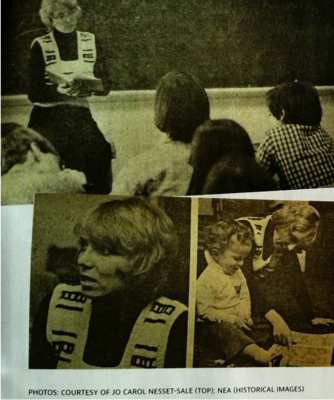
Source. Then and Now: A Pregnant Teacher Xhanged Family Leave Laws Foreever. neaToday May 2025.
Dorothy Raffel (14) tries to play competitive high school sports (basketball) in Pennsylvania.
The Women’s Equity Action League files a class action suit (Adams) against the federal U.S. Department of Health, Education and Welfare for failure to enforce Title IX in the 1972 Education Amendment. The complaint is never fully resolved.
1973
U.S. Supreme Court rules a state can not fund textbook programs for schools who engage in racial discrimination. "Racial discrimination in state-operated schools is barred by the Constitution." Norwood v. Harrison (p. 464-465)
Judge jails three teachers for leading an insurrection of K-12 educators
Washington’s Evergreen Education Association (WEA) go on strike demanding a collective bargaining contract, improved pay, reduced class sizes, (currently some with 41 students), planning time, and better relationship between the superintendent and teachers.
- On May 17 a judge order the teaches back to work, the union refuses, and the judge orders union leaders Dick Johnson, and Fred Ensman jailed.
- On May 21 the judge orders them back to work, and the union leader John Zavodsky refuses to stop the strike and return to work and he is put in jail.
- The WEA elects a long time kindergarten teacher, Betty Cowell as interim president.
- She tells the board. In all my life, I’ve never had so much as a traffic ticket, but I’m telling you, right here and now, I’m prepared to go to jail tomorrow — and it’s your fault.
- May 22 Betty along with 300 other teachers, each carrying a plastic bag with underwear and a tooth brush arrive at court. They tell the judge they are here to surrender. The judge, tells the school board members to bargain in good faith or they’d be jailed. A federal mediator joins the negotiations.
- May 29 an agreement is reached and the teachers return to work. The three jailed teachers refuse to admit they were wrong and apologize so they Judge demands they continue serving their 90 day sentences.
- In June a new superintendent pleads for their release. It is granted after 45 days and 43.
1972
Title IX Education Amendment, Section 1681- Sex.
Congress prohibits discrimination on the basis of sex. Like Brown v. Board of Education a law needs a way of enforcement.
No person in the United States shall, on the basis of sex, be excluded from participation in, be denied the benefits of, or be subjected to discrimination under any education program or activity receiving Federal financial assistance.
Supreme Court rules School finance is to be decided by the states, as there is no constitutional right for education
San Antonio Ind. school District v. Rodriguez Rodriquez challenged the equality of funding to his property poor school district compared to property rich districts. The U.S. Supreme Court ruled there is no constitutional right to public education and this disparity was not focused on any suspect classification of students that warrant legal protection.
While people generally view local school board control of education as positive, it neglects how to achieve equity among extreme financial disparity of rich and poor school districts across the country. Disparity that results from a reliance on local property taxes to fund education and not being able to receive additional sufficient funds from state or national governments.
Inequities in rural, urban, and areas in between, that restrict coarse offerings, quality of materials, quality and availability of teachers, administrators, support staff, and quality of services offered. Lack of funiding also affects before and after school activities, extra curricular activities, clubs, diverse of student populations, and stress associated from insufficient resources, low salaries, and difficulty to attract qualified employees.
Swann v. Charlotte-Mecklenburg Board of Education The Supreme Court rules the federal courts have the discretion to use busing as a desegregation tool for racial balance. However, in Milliken v. Bradley restrictions are imposed.
The court bases the insufficiency of the current school systems on six aspects of school operation: student racial composition, faculty, staff, transportation, extracurricular activities, and facilities.
Later in 1971 in Swann v. Charlotte-Mecklenburg Board of Education they expanded these factors to include the impact of school construction and closures, attendance zones, and school transfer policies on segregation and inequality between schools attended by students of different races.
While courts may determine meaningful accountability frameworks, much remains to be done to achieve equity for many students.
In Wisconsin v. Yoder the U. S. Supreme Court rules in favor of home schooling by the Amish.
Summary of instructional changes in the 1960's, 1970's & shortly beyond
Instruction and planning became systematized, standardized, and proceduralized
Mastery learning and mastery teaching 1967+
Benjamin Bloom, Learning for Mastery (1968). Advocated, mastery learning, instruction that used assessment initially and periodically to identify what students know so feedback with corrective procedures could be determined that match students needs to enhance their learning so they might attain master of content at an accuracy level of 90% or higher. If students didn't achieve mastery, after initial instruction, they would cycle through more instruction. While those who were successful were given enrichment activities to elaborate and deepen their understanding.
Mastery Teaching
Madeline Hunter's approach to master was described in a seven step instructional, which she referred as elements of a lesson design. Briefly the first four steps; were to focus on, define, provide input, and model the intended learnings; followed by three assessment steps: to check for understanding, and assess during guided and independent practice. The planning guide was part of what she called an Instructional Theory into Practice Teaching Model (ITIP).
- Madeline Hunter Teach More–Faster!. (1967)
- Madeline Hunter Teaching Is Decision Making. (1979) Educational Leadership 37 (1):62–65.
- Madeline Hunter. Mastery Teaching. 1982
Source for more information about Madeline Hunter
Constructivist 1967+
John Dewey and others advocated Constructivist teaching early in the early 1900's, however, it wasn't until 1967 that a systematized constructivist instructional theory was introduced: The Learning Cycle by Robert Karplus and Herbert Thier as a conceptual organizer to guide the teacher's interactions with a classroom of students. Three stages: exploration, invention, and discover were included that are characterized by:
- Student-centered. Accepts students have preconceived ideas they must explore and discover their value based on reasoning and data.
- Observation of concrete materials to use as evidence combined with primary sources must be used for students to explore, invent, and discover new ideas.
- People learn by equilibration.
- People learn with their exploration, categorization, communication, construction, negotiation, translation, extension, reflection, and self-assessment to construct explanations and understanding.
- Teachers understand learning is interactive and they must encourage students with questions, wait-time and encourages them to be open-minded as they negotiate construction of explanation and understanding.
- Embedded in the a learning cycle theory is initial recognition of the importance of self, beliefs, motivation, metacognition, cognitive theory, and knowledge expression (how what is deemed important to learn is defined and expressed, as subjects, literacy, integration, curriculum ...).
Cooperative learning 1974+
Early contributions 1900-1950
- Social theory began to recognize cooperative learning was more effective and efficient in quantity, quality, and overall productivity than working alone.
- M. May and L. Doob found that people who cooperate to achieve common goals, were more successful, than independent people who completed the same goals. The independent achievers also demonstrated more competitive behavior.
- John Dewey's contributions to today's cooperative learning theory are: importance of school and democracy, students as active recipients of knowledge, students being engaged in the learning process, students communication with peers, and less teacher lecture.
- Kurt Lewin’s contributions to cooperative learning are: ideas of the importance of relationships between group members to achieve learning goals.
- Morton Deutsh’s contribution to cooperative learning was positive social interdependence, and student responsible to contribute to group learning.
These ideas were combined by David and Roger Johnson into a systematized planning and instructional procedure and cooperative learning theory from the mid 1970's into the 1980's and 1990's.
In 1975, they identified that cooperative learning promoted positive relationships between students, positive feelings about the subject matter, better communication, higher achievement, and greater use of higher-order social, personal and cognitive skills. Johnson and Johnson published the 5 elements positive interdependence, face-to-face interaction, individual and group accountability, interpersonal or small group skills, and group processing. Cooperative learning theory, benefits, elements, steps, strategies, and planning information.
Reciprocal teaching 1982+
Brown & Paliscar developed reciprocal teaching, a type of cooperative learning developed for reading. It has been expanded for other subject areas with a more general procedure that can be used with pairs or small groups.
1970
About 70% adolescents completed hight school and earned a diploma. See 1900
Supreme Court rules on the use of intelligence tests to discriminate.
Griggs v. Duke Power Company Black employees sued their employer, Duke Power Company, contending that it violated the Civil Rights Act of 1964 by requiring a high school diploma and a satisfactory intelligence test score for certain jobs previously limited to White employees. The Supreme Court ruled these employment requirements did not relate to the ability of an applicant to perform the job. Therefore, they discriminated against Black employees. Source
Kent State Riot. Kent, Ohio May 4, 1970. 2,000 students gathered to protest President Nixon's announcement to invade Cambodia when members of the National Guard fired 67 rounds into the crowd. In the following days small fires were set, window destroyed, and an ROTC building was set on fire. Four protesters were killed, and nine were injured.
After the Brown v. Board of Ed. ruling in 1954, additional cases were brought that questioned the decision’s application. Judges narrowed the application to the ruling by claiming it only applied to segregation created by laws or state action (de jure segregation). Another limitation is the population of students.
In Cisneros v. Corpus Christi ISD the school segregated Mexican American student by claiming, since there was no law or state action for segregation of Mexican American students, any segregation of these students was de facto segregation, and Brown shouldn’t apply. The court rules, both de jure and de facto segregation existed in the Corpus Christi school board decisions about attendance zones, where to build, and student transfers perpetuate segregation.
1969
Congress passes the Children with Specific Learning Disabilities Act. 1969
The first time federal law mandated support services for students with learning disabilities. It was The Elementary and Secondary Education Act Amendments of 1969: Title VI, Included in the Education of the Handicapped Act.
National Assessment of Educational Progress (NAEP). 1969
Created to assess the state of education in the U. S. It has been tauted as a model assessment program. It uses a matrix sampling design, does not require any student take the entire test in any subject, combines open-ended questioning with multiple-choice, is a criterion-referenced test, and is designed for longitudinal comparisons. With standards of comparison set high, student performance can cause questionable concerns that can be exploited with both positive and negative consequences.
Sesame Street debut. November 10, 1969
Joan Ganz Cooney, former documentary producer for public television, creates a pioneering TV show to teach young children. The show will evolve beyond teaching the alphabet and how to count, to include many issues relevant to young children. Its theme song Can you tell me how to get ... How to get to Sesame Street is one of the most recognized songs in the world. Sesame Street's setting is, today in a New York neighborhood. Characters are ethnically diverse. Plots are short fast moving vignettes that teach literacy and have themes with positive social messages. It debuts the Muppets created by Jim Henson. The World of Puppetry: A look through theatre history.
Fred Rogers appeared before the United States Senate Subcommittee on Communications in 1969. To gain support for funding for PBS and the Corporation for Public Broadcasting, in response to significant proposed cuts by President Nixon. See his 6:50 presentation recorded on Video.
The Supreme court rules for Tinker, but also claims school districts can restrict disruptive speech.
In December 1965 school officials hear some students plan to wear black armbands to school in support of a Vietnam truce. Students are warned that if they do, they would be sent home. Beth Tinker, John Tinker, & Christopher Eckhardt do and are sent home. Their parents file suit claiming a violation of their free speech.
Tinker v. Des Moines Independent Community School District rules (7-2) in the favor of Tinker. Justice Abe Fortas writes in the majority opinion:
- Students have freedom of speech or expression:
It can hardly be argued ... students ... shed their constitutional rights to freedom of speech or expression at the schoolhouse gate.
- The state can not prevent students from expressing ideas simply because their message may run contrary to the state's preferred message.
- Emphasizes it is the school's responsibility to educate citizens capable of civic discourse and to do so requires free and open debate of all ideas.
The court considers three issues to consider when regulating student speech.
- If the school expects the speech to substantially disrupt or interfere with school activities. (Tinker did not.)
- If the speech materially and substantially interferes with the discipline in the operation of the school and collides with the rights of others. (Tinker did not.)
- School officials can not prohibit expression based on classmate's disruptive reaction to the speech. It must be the speaker themselves that disrupt school activities. (Tinker did not.) This is known as the heckler's veto.
If the [state] can silence the speaker, the law in effect acknowledges a veto power in the hecklers who can , by being hostile enough, get the law to silence any speaker of whom they do not approve. Harry Kalven 1965
Justice Abe Fortas summarizes the contentiousness of free speech.
Any variation from the majority's opinion may inspire fear. Any word spoken, in class, in the lunchroom, or on the campus, that deviated from the view of another person may start an argument or cause a disturbance. But our Constitution says we must take this risk, and our history says that it is this sort of hazardous freedom-that this kind of openness-that is the basis of our national strength and of the independence and vigor of Americans who grow up and live in this relatively permissive, often disputatious, society. Justice Abe Fortas
Mexican American students boycott
On December 9, 500 students walk out of Crystal City High School and begin a student boycott to demand the curriculum, teachers, and administration treat Mexican Americans fairly and respectfully. Among their demands is to respect the importance of bilingual education. Over the days the number of participants reaches over 2,000. After a month of negotiations the school boycott ends on January 6, 1970, The boycott encourages Mexican American parents to run for school board and people in other cities to become active in the civil rights movement. Source
1968
Black studies and Black curriculum demands met
San Francisco State University student groups, Black Student Union (BSU) and Third World Students, go on strike and sit in for four months with 600 arrests. The strike ends when parents and community members come to the defense of the students and a compromise is reached.
Demands met include: a Black Studies Department, Black studies professors (however, demand of Nathan Hare to be its Chair is not met), BA in Black Studies is added, Black students previously admitted without traditional requirements were retained, increase of Black student enrollment, changes to better meet financial needs of Black students, amnesty for some students arrested (some would be put on an unofficial black ball list), and development of a School of Ethnic Studies.
The Black studies movement grew from the Black liberation movement, Black power, Black rights, and Civil Rights movements of the sixties.
Source African Studies … History … in The Journal of Pan African Studies, vol.5, no.7, October 2012
Mr. Roger's Neighborhood first appeared as a national program on WQED Pittsburgh PA.2/19/1968.
Over the years, guests have included: Tony Bennett, Yo Yo Ma, Nicolas Ma (Only two times that he performed with his father), John Lithgow, Wynton Marsalis, Whoopi Goldberg, Joe Negri, Judd Apatow, Esparanza Spalding, Bob Rowsharne, Sarah Silverman, Koko, Jeff Erlanger, Ed Zach Perlman, Carol Spinney, Margaret Hamston, Chris Kratt, Joyce DiDonato (wicked witch in Wizard of Oz talks about real & pretend and puts on her witch costume) Big Bird (was only in Make believe since Big Bird wouldn't remove costume) Niki Hoeller, Empire Brass Quintet, Chuck Aber, Ella Jenkins.
Cast members: Michael Keaton, David Newell, Joe Negri, Betty Aberlin, Johnny Costa (house band)
Sample content:
- 1969 Mr Rogers and a Black police officer (Froncois Clemmons) share a pool and Fred dries his feet.
- Real v. pretend example with Joyce DiDonato - wicked witch in Wizard of Oz talks about real & pretend as she puts on her witch costume.
- Big Bird - is only in Make believe since Big Bird wouldn't remove its costume to show the difference between real and make believe.
- Live birth of kittens.
- Many documentaries of how different things are made.
- Describe how to be a good kid.
- Inspired us to be better.
- Song - It's You I Like
Sample themes:
- Friendship and love don't cost anything and are they are so important
- Feel good about doing and do something
- Showing what is possible.
- Modeled love of learning.
- Be willing to be vulnerable and learn.
- There is much to learn in the world,
- Willing to try without a fear of failure.
- Mistakes are part of learning.
- Somethings are hard to learn.
- It's okay to sometimes want to do things and other times not want to do things.
- Play together grow together
- It will be OK if you can talk about it
Other significant events: Fred Roger's Timeline
- April 5, 1955 The Children's Corner premieres hosted by Josie Carey and co-produced by Josie and Fred Rogers. Included the Neighborhood and Make Believe favorites: Daniel Striped Tiger, X the Owl, King Friday XIII and Lady Elaine voiced and operated by Fred Rogers.
- 1969 - Fred Rogers appears in Congress to support PBS.
- 1983 - Eddie Murphy debuts his Mister Robinson’s Neighborhood on SNL. Season 9, Episode 2.
- 2001 - The last new episode of Mister Rogers' Neighborhood airs. (8/31/2001)
- 2012 - Daniel Tiger’s Neighborhood premieres, produced by The Fred Rogers Company.
- 2018 - Won't You Be My Neighbor movie
Epperson v. Arkansas
The United States Supreme Court held an Arkansas law, that prohibited the teaching of evolution, unconstitutional. It ruled the First Amendment of the U.S. Constitution does not allow a state to require teaching tailored to the principles or prohibitions of any particular religious sect or doctrine. See 1982
Green v. County School Board
Enables the federal government to enforce desegregation orders.
1967
Professionalization of Nebraska public school teachers.
- Teaching K-12 is recognized as a profession (LB 457) and the Professional Practices Commission is created.
- K-12 teachers are given a three year probationary period after which they are protected against unwarranted and unjustified dismissal with a hearing process.
- Teachers are given the right to negotiate salaries and benefits (LB 485)
- Falls City Education Association is the first to complete a negotiation agreement and salary schedule under the provisions of LB 485.
Source The Voice February 2017, NSEA at 150.
American Educational Research Associate (AERA) splits from the National Education association (NEA)
A split that separates educational research from professional educators.
Public Broadcasting Corporation is created
Carnegie Commission on Educational TV report helps pass the Public Broadcasting Act, which establishes the Public Broadcasting Corporation. See 1969 for funding debate & Sesame Street Debut
Hobson v. Hansen
The federal court abolishes the District of Columbia’s tracking system.
Designed … as a means of protecting the school system against the ill effects of integrating with white children the Negro victims of de jure separate but unequal education.
1965
Elementary and Secondary Education Act (includes Title 1).
- Provides federal funding ($4 billion) based on the number of poor students (as part of President Johnson's war on poverty) in a school district through the Title I part of the act. Funding varies from one-fourth to one-half of what is promised for the next fifty years and counting.
- Funding requires integration as a way to enforce the Brown vs. Board of Education of Topeka ruling.
- Support services include math and reading for children in low-income schools.
- Funding requires norm-referenced objective testing measures to identify students and evaluate their achievement.
- Evaluation measures will have a large impact on student assessment as most districts and a majority of elementary schools in the U.S. use these funds.
- In years to come Title I would be renamed Chapter 1.
Public reflects on academic and vocational education
Harris expresses his belief on the failure of a curricular emphasis on science, math, and language for everyone and a need for vocational education. However, while each track should prepare every student for different ways of work, all subjects should not be different for students in the different tracks, as all students need and deserve a liberal education:
"Suddenly parents, legislators, and citizens in general have discovered that a Sputnik-spawned curriculum has some drawbacks when applied to schools which serve all youth through their seventeenth year. Suddenly, there are no jobs for the new high school graduate with his modern math, and new physics, and three years of French. Suddenly, there is serious questioning of the validity of a high school curriculum which places two-thirds of its emphasis on the needs of one-third of the students. Suddenly, parents are asking, “Why doesn’t the high school give my boy an education which will prepare him for a job? And so we have come full circle. Vocational education, after dwelling in limbo for ten years, is fashionable again. (Redoubled Efforts and Dimly Seen Goals. Kappan April 1965. p. 360)
Lloyd Williams expresses his belief that both academic and vocational education are important:
"The liberal and vocational disciplines need one another. Life requires them both; an adequate personality demands them both. The vocational aspect of education and of life needs enrichment; it needs to be brought under the scrutiny of critical intelligence; it needs the illumination that comes with comparison; it need the clear delineation provided by historical perspective; it needs the invigoration that comes from lose involvement wit the liberal disciplines. But by the same logic, the liberal disciplines need focus; they need to be pointed in some useful direction; they need association with the practical to overcome their abstract remoteness; they need to be tempered by the world of human problems; they need the enrichment with functional studies. (The Struggle for Balance. Kappan April 1965. p. 359)
Voting Rights Act passes and signed by President Lyndon Johnson.
1964
Largest student led protest is at the University of California Berkeley on December 2, 1964. 1,500 students protest the expulsion of students involved in a Free Speech Movement by camping out in a campus building before being removed by police. Over 750 students are arrested. The university choses not to expel them and lose tuition, which is a large amount of the school's budget.
Civil Rights Act passed and signed by President Lyndon Johnson. Includes lose of federal funds if schools didn't integrate and if they did, they could receive money through the Elementary and Secondary Education Act.
1963
Learning disability.
The term learning disability is used for the first time by Samuel A. Kirk at a conference in Chicago.
James H. Meredith, is the first African American to graduate from The University of Mississippi on Aug. 19, 1963. The University ignored a court order to enroll him until President Kennedy sent U.S. troops, National Guardsmen, U.S. Marshals, and the Governor sent state highway patrolmen to the Ole Miss campus on September 29, 1962. Tear gas and gunfire left scores wounded and two men dead. Source
In Abington School District v. Schempp on June 17 the U.S. Supreme Court rules 8-1: Bible reading at school violated the principle of strict neutrality and
" ... no state law or school board may require that passages from the Bible be read or that the Lord's Prayer be recited in the public schools of a State at the beginning of each school day -- even if individual students may be excused from attending or participating in such exercises upon written request of their parents." Source
1962
In Engel v. Vitale the U. S. Supreme Court bans organized prayer in schools
Rules:
The Establishment Clause [in the first ammendmen of constitution] may be violated ... when the power prestige and financial support of government is placed behind a particular religious belief, the indirect coercive pressure upon religious minorities to conform to the previling officially approved religion is plain.
1960 see summary of 60's and 70's.
Child Centered Curriculum. 1960+
Personal relevant curriculum
- Reconstruct society for a liberated existence: Paulo Freire rejects the present Banking Model of Education and calls for more relevant curriculum in Pedagogy of the Oppressed (1970). and continues to speak for change until his last book, Pedagogy of freedom: ethics, democracy, and civic courage (1998).
- Whole language
- Open education and open schools
- Elective movement to provide personal relevance through choice in classrooms with learning centers, multiple activities, mini-lessons, multiple electives,and different tracks to graduation.
See also Progressive Education
- John Dewey
- Jean Piaget - While most of Piaget's work on his theory of child development and cognition is in the 1940's, the arrival of his ideas to America are most influential after 1960 along with Inhelder. Ideas related to Piaget and Inhelder for child and adolescent development. No other theory has undergone such scrutiny and verification than his ideas for the development of mathematico-logical reasoning. Particularlly with respect to conservation and formal operational thinking. Questions with respect to the generalization of his ideas from research on his children to the world's population have been repeatedly investigated with virtually all cultures on Earth and have withstood all attempts to find counter examples. Further, his theory and subsequent studies have refuted Bruner's claim that anyone can learn anything at any age if it is presented to them in an appropriate instructional sequence.
- Sylvia Ashton-Warner
- Lucy Sprague Mitchell
- John Holt
- Jonathan Kozol
- Bank Street Schools and Progressive education
- Lillian Weber Bio. and papers
- Alfie Kohn
1959
The Woods Hole Conference was held, as a response to the Soviet Union's launch of the Sputnik series of satellites, to identify the problems of science education and to recommend solutions.
American educators who, feared the Soviet Union has passed the United States in science, math, and foreign language achievement. Educators meet to discuss and consider what might be done. Their conclusions is to bring together distinguished people from different fields to plan and suggest general ways to improve education. Their suggestions center on conceptual learning of discipline-based subject matter and the need to identify instructional methodology that can improve student achievement.
1958
National Defense Education Act - Millions of dollars are provided to expand math, science, foreign language, and guidance programs.
Iowa tests introduce computerized scoring and reports to schools.
Clifton Hillegass creates Cliff Notes
He creates them as a study guide to use while reading and studying the text for which each is written. He respected intellectual exploration, earned a graduate degree from the University of Nebraska, and endowed a professorship there. Was disappointed when students would misuse them.
1957
Sputnik launch by the Soviet Union on October 4, 1957 and American education is questioned.
Many educators call for teachers and curriculum to include more rigorous subject matter knowledge and information. At first, instructional methods are not mentioned. However, in a few years the quality of instructional methods along with curriculum is considered as necessary for student success. See Woods Hole Conference 1959.
1956
- Benjamin Bloom, Handbook I: Cognitive (1956).
- Krathwohl, Bloom & Masia Handbook II: Affective (1965)
First female professor named at Harvard.
Cecilia Payne-Gaposchkin after her death. Astronomer who discovers stars have millions more times hydrogen than previously believed. See What Stars Are Made of: The Life of Cecilia Payne-Gaposchkin
1955
Complaints about schools, teachers, and education becomes common
Publications like: Why Johnny Can’t Read, book and magazine article, fuel criticism about education in general, even though most think their schools are okay. It also starts the phonics v. look-say debate, which later becomes phonics v. whole language debates.
1954
Brown v. Board of Education of Topeka.
The Legal Defense Fund filed a class action lawsuit on behalf of Black parents in Topeka, Kansas whose children are required to attend segregated schools for Black students. Their attorney, Thurgood Marshall, challenges the doctrine of, separate but equal, created in 1896 by the Supreme Court ruling in Plessy vs. Ferguson.
The equal protection ruling in Brown is later applied to laws and rulings for the right of equal access to public and political areas for all.
The Supreme Court rules 9-0 on May 17, 1954 that:
- Where a State has undertaken to provide an opportunity for an education in its public schools, such an opportunity is a right which must be made available to all on equal terms.
- Segregation of children in public schools solely on the basis of race deprives children of the minority group of equal educational opportunities, even though the physical facilities and other "tangible" factors may be equal.
- The "separate but equal" doctrine adopted in Plessy v. Ferguson, 163 U.S. 537, has no place in the field of public education.
- Orders the integration of schools with all deliberate speed.
Chief justice Earl Warren
Today, education is perhaps the most important function of state and local governments. Compulsory school attendance laws and the great expenditures for education both demonstrate our recognition of the importance of education to our democratic society.
A down side of Brown is, Black schools close and the number of Black educators decrease. This severely limits the number Black teachers and role models available in schools. Which in turn limits the kind of necessary education they provided that taught the skills to resist and repair damage caused by racial discrimination of minorities so they could flourish in an oppressive world. Additionally this dehumanizes and erases minority cultures and achievements and distorts the nation’s history. Source Coming to terms with the power of teaching. By Deborah Loewenberg Ball. Kappan April 2022.

Inspired Blackbird by Paul McCarthy
Bolling v. Sharpe
The U. S. Supreme Court rules the District of Columbia’s racially segregated public school system violates the due process clause of the fifth amendment.
The invention of television causes reformers to believe educational television could improve education by with broadcasts by the best teachers. WQED in Pittsburgh develops arithmetic, reading, and French programs and begins to broadcast them in 1952.
1951
Life Adjustment Curriculum.
Life Adjustment Education for Every Youth is published by U.S. Office of Education and a national conference on life adjustment is held in Washington D.C. Hundreds of thousands of teachers and administrators attend workshops, conferences, and state sponsored committees between 1951 and 1953. Source
The curriculum is meant to provide a better match for most students so they are prepared for adulthood and work. The belief that the current curriculum to be about 60%, who did not benefit from college prep or vocational ed. It was characterized by:
- Life skills: hygiene, family living, drivers’ ed, and social relations with peers
- Basic skills
- Curriculum that is more meaningful and relevant., that allows students to develop at different rates, that is related to student's ability, and had more general and specialized outcomes.
- Career and vocational education
- Emphasized the dignity of work
- Emphasized moral living
For example history became social science, integrated with geography, civics, political science, economics, anthropology, archeology, sociology, and psychology, in units of study of a state, city, or community to make it more dynamic and responsive by including areas of living to meet the needs of the child and adolescent for a social world. Prepare them for group living, family life, to create a home, live healthy, engage in civic and community life, enjoy and protect life. Social studies teachers coordinated their efforts with guidance counselors, who administered personality and ability tests to students to help them make decisions about careers and vocations.
History came to be seen as shallow, chronological, outdated, irrelevant, unnecessary, and impractical. Resulting in students not learning disciplined reasoning about the past to understand how it lead to the present and enables the future. Lost and replaced with an anti-intellectual view that history is bunk resulting in a complacent middle class unaware of their manipulation and ignorant in how to facilitate change.
Thomas D. Fallace believes the responsibility for the mind numbing aspects of the history curriculum after World War II is not John Dewey or the Committee on Social Studies in 1916, but the national and local curriculum writers who added Life Adjustment Education into curriculum. Source
Summary of changes 1850 - 1950
When Mississippi, in 1918, is the last state to make education compulsory for all. This not only makes school attendance mandatory, but in time it leads to an ever increasing role for state government in education; for setting and enforcing rules to regulate schools and their teachers, administrators, curriculum, and assessment. Tthe regulation of teachers leads to certification and the identification of requirements for teachers so that they move to being considered professionals.
Professionalization of teachers
These state regulations, along with the increasing numbers of educators who graduate with four year degrees from: land grant colleges, normal schools, and Universities such as Chicago and Columbia; along with the increase in literature relating to education by authors such as John Dewey; and teacher organizations: National Teachers Organization (NEA) and American Federation of Teachers (AFT) along with a desire for higher wages; began to lead to the professionalization of teachers.
This professionalization
Unions form where there are labor and trade disputes as groups of people join together for the betterment of their cause. These groups are historically small and most likely local. See early twentieth century.
The industrial revolution and larger populations of the 1880's give rise to labor organizations like: The Knights of Labor in the late 1880s, but due to its leadership and poor organization it is unable to survive strong opposition from employers and government officials.
In 1886 the American Federation of Labor is founded, led by Samuel Gompers, and is much more successful. It starts as a loose coalition of local unions that begin to coordinate and support strikes. Franklin Delano Roosevelt is elected and in 1933 passes the National Industrial Recovery Act, which declares:
...employees shall have the right to organize and bargain collectively through representation of their own choosing, and shall be free from the interference, restraint, or coercion of employers. the right to organize into unions.
Fair Labor Standards Act passes in 1938. It establishes national minimum wages and hourly standards, including overtime pay or compensatory time for over 40 hours of work a week. The law does not provide protection for many employee’s. Teachers and doctors, lawyers, and other salaried employees are excluded. While this will work out well for doctors and lawyers, it will supress teacher’s salaries, which in turn drives down recruitment and retention.
Additionally the Fair Labor Standards Act excludes teachers from participating in social security. Without these benefits, teachers, will not have any retirement benefits. To address this, teachers in some cities and states organize to gain retirement benefits at the district or state levels. These benefits are one of two types. First, defined benefits, or pensions that provide benefits or a pension with a guaranteed steady income after retirement dependent on years of service. And undefined benefits, like a 401(k) or 403(b) which depends on investment strategies (stocks, bonds, or interest rates) for what’s invested, which is a highly variable and unreliable source for retirement.
One reason for teacher’s exclusion from social security is the public’s different views of whether teachers should be viewed as lifelong professionals, usually thought of as a male high school teacher, or temporary positions for young women before marriage, thought of as elementary teachers. Thus teaching, as a temporary job, rather than a professional job, can greatly reduce funding of education. And because teacher’s salaries are the biggest cost when providing education, which effects tax rates, tuition rates, and profits of private schools, a 30% reduction in salaries yields a large decrease in tax dollars required or a large increase in profits.
The National Industrial Recovery Act is declared unconstitutional by the U.S. Supreme Court in 1935.
It is replaced with the Wagner Act in 1935. The Wagner Act, legally protects the right of employees to organize in unions.
The Taft-Hartley Act amends the Wagner Act in 1947 to prohibit unfair labor practices of unions. In 1959 the Labor Management Reporting and Disclosure Act, adds further restrictions for organized labor.
1950
About 33% American White women over 25 completed high school and only 5% graduated college
Milton Friedman applies his idea of free market to education.
Friedman proposes changing public education to a free market system with school choice through charter schools, magnet schools, and cross-district choice to achieve greater privatization and marketing of schools.
He and his wife, Rose Friedman, start the Foundation for Educational Choice, later Edchoice.
1949
Ralph Tyler claims curriculum design should include four steps: selecting objectives, determining learning experiences, organizing activities, and planning for evaluation. Curriculum documents followed this procedure and resulted in documents with:
- Observable behaviors and attitudes,
- Lists of suggested learning activities, and
- Suggestions to evaluate student achievement of the desired attitudes and behaviors.
- Organized content in units based on current interdisciplinary problems instead of as academic disciplines in chronological order.
1947
Everson v. Board of Education
the Supreme Court rules taxes cannot be used to support
any religious activities or institutions, whatever they be called, or whatever form they may adopt to teach or practice religion.
1946
California judge rules against segregation
Five Mexican American families in Los Angels, CA seek to stop the segregation of their children. In Mendez v. Westminster, Mendez claims Mexicans are not included in the list of groups permitted to be segregated by California law. Westminster claims they were segregated to meet their instructional needs as English language learners. The judge found the segregation mostly based on the last name of the child as Latin or Mexican origin and not educational needs. The judge notes, student needs would be better met if they are placed among English speakers and the integration of students is imperative to perpetuate the American ideas and institutions. Whereas, segregation is misguided and thwarts an opportunity to develop a common cultural attitude.
1944
This Bill combines previous bills, starting with the Morrill Act in 1863 which opens higher education to larger numbers of people. Making the United States a leader in the numbers of people going into higher education.
James Bryant Conant
Becomes President of Harvard University with a reform agenda. While president, Harvard abolished; class rankings, Latin requirements, and athletic scholarships. Harvard begins the use of the Scholastic Aptitude Test (SAT), co-educational classes, and admits women to Harvard Medical School and Harvard Law School for the first time.
He commissions a study into what kind of general education is needed for a free society. In 1945 their report: General Education in a Free Society, concludes the complete man must be a good man, take a balance of science and humanities course work with the goal to achieve a holistic liberal education that fosters creativity, flexibility, and open mindedness.
1943
Supreme Court overturns 1940 compulsory flag Pledge decision.
West Virginia State Board of Education v. Barnette the school board requires all teachers and pupils to honor the Flag. If they refuse to salute, they were expelled and charged with delinquency. Justice Frankfurter notes, schools in every state had expelled 2,000 students for refusing to cite the Pledge as a result of previous rulings.
See 1940.
In this case the US. Supreme Court rules (6-3) a school could not force students to stand and say the Pledge of Allegiance and could not penalize them for not doing so and declare the Constitution protects all citizens against the State and all of its creatures.
Justice Jackson argued,
"If there is any fixed star in our constitutional constellation, it is that no official, high or petty, can prescribe what shall be orthodox in politics, nationalism, religion, or other matters of opinion or force citizens to confess by word or act their faith therein."
“That [public schools] are educating the young for citizenship is reason for scrupulous protection of Constitutional freedoms of the individual, if we are not to strangle the free mind at its source and reach youth to discount important principles of our government as mere platitudes.”
This ruling is the first meaningful step establishing student constitutional rights within public schools.
Willard Youngdal, expresses his and others wide held belief on the importance of a liberal education on the kind of education required after the war for people in power who make good decisions.
"only those persons who are liberally educated can be trusted with the planning of the peace. A technically trained specialist does not have the depth of background or breadth of understanding necessary for an intelligent grasp of postwar problems." (Why Liberal Arts Now? Kappan. 1943. p. 136)
1942
Eight-Year Study. 1942.
Conducted by Euros, Raths, Taba, Alberty, Traxler, French, Corey, Ryan, Mackenzie, Harap, and Tyler the study validates the progressive education movement ideas.
The researchers also found that secondary schools in the Eight-Year Study were stimulated to develop new programs which were better for young people, for their success in college, for success in life, and for the future of society. Source
The study includes the following ideas to improve instruction.
- Subjects to cut across subject-matter lines.
- Frequently use cooperative planning and teaching.
- Explore a wide range of relationships.
- Provide experiences valid for large groups.
- Include subject matter which does not require extended drill in specific skills (such as the operations).
- Use larger blocks of time than a single period.
- Used a wide range of source material techniques for gathering information and class room activities. Source
Unfortunately the release of the five volume report is over shadowed by events leading to WW II and the war itself.
See 1919 Progressive Education Association for other characteristics.
GED (General Education Development). 1942
In November 1942, the United States Armed Forces Institute asks the American Council on Education (ACE) to develop a battery of tests to measure high school-level academic skills so military personnel and veterans might demonstrate their knowledge to get civilian jobs and enroll in post-secondary colleges and universities.
The University of Iowa is contracted to create the test and the test created is used until 1978. Since then several revisions have taken place with the latest in 2014 being an electronic version, the Pearson Vue.
1940
50% of all 18 year olds graduate high school.
75% of 14-17 year olds are in high school.
United States Supreme Court rules forcing students to recite the Pledge of Allegiance does not violate the student’s first amendment rights.
Minersville School District v. Gobitis. Minersville School expels a student who is a Jehovah’s Witnesses for refusing to recite the Pledge of Allegiance. The court rules reciting the Pledge does not violate the student’s first amendment rights. The court claims it would be improper for the judiciary to overturn educator’s decisions or to debate educational policy, as the court lacks competence to do so. Judges should mind their own business and let educators do their business of molding minds. See 1943
1937
Future Teachers of America is founded by Joy Elmer Morgan who is born in Callaway, Nebraska and graduates from the University of Nebraska, Lincoln. He becomes the first executive secretary of the National Teachers Association (NEA) in 1917, is director when the NEA has its first Representative Assembly in 1920, and moves its headquarters to Washington D.C. Where it is located today.
Source: The Voice March 2017
1938
Indiana ex rel. Anderson v. Brand
The U.S. Supreme Court rules that tenured teachers could not lose their rights to a continuing contract through a repeal of the state's tenure statute.
1934
First automated test scanner IBM 805 is developed and used into the early 2000's
Iowa basic skills standardized tests are made available outside Iowa
B. F. Skinner (1904 -1990) Behaviorism & Cultural transmission theory and philosophy.
Skinner builds on Thorndike's ideas that teaching could be reduced to highly controllable methods and explores systematic planning strategies for teaching and learning, teaching as a science, effective instruction, and teaching as a technocrat.
Behaviorism, behavioral psychology, and behavior modification as a philosophy or psychology explains people's actions as a result of their interactions with their environment (stimulus) and the type of reinforcement received as a result of their actions or behaviors (response). Direct instruction, Mastery learning, and educational technology have strong behavioral roots.
It assumes all people have potential and can change their behavior. A teacher could use a behavioral theory with a focus on each person's learning behavior. Identify specific objectives that describe targeted behaviors, use action verbs to describe tasks learners can do to demonstrate attainment of objectives, sequence learning tasks, decide on types of reinforcements, systematic implementation with timing of feedback and correction, praise, reward, and punishment to shape small incremental improvements toward the target behavior.
In its early years it rules out consideration of mental activity as not being observable and hence unscientific. Over the years it evolves to being described as a branch of psychology that focuses on the study and alteration of people's behaviors, including their actions, emotions and thoughts.
A focus on behavior is not necessarily behaviorist.
Other related contributors to Behaviorism: A. H. Thorndike, John Watson, John Locke in his An Essay Concerning Human Understanding. 1689, Ivan Pavlov,
Harvard adopts the SAT to select scholarship recipients. Decades of research will demonstrate its negative bias against minorities.
1931
California judge rules against segregation of Mexican American students
Alvarez v. Lemon Grove. After completion of a new school building school officials claim, to best meet educational needs of all Mexican American students, it is necessary to segregate them in one school. The California judge rules state law did not authorize or permit separate schools for instruction of students with Mexican parents or descent.
1930
Depression affects student welfare and school finance
The Great Depression causes many families, who can't provide for their needs, to become dependent on state and federal government for assistance. Education relies on property taxes, which decrease as businesses fail and land values fall. In 1934 Chicago borrows $22 million so it could pay teacher salaries that were owed for three years of work.
Independent School District (Del Rio, Texas) v. Salvatierra rules Mexican American children could be segregated for instructional purposes based on pedagogical expertise of school administrators, even if it results in racial segregation.
1929
University of Iowa begins the first statewide testing program for high school students under the guidance of E.F. Lindquist.
The National Educationol. Association (NEA) publishes a report warning teachers about accepting free corporate classroom materials.
1928.
Report - The Problem of Indian Administration - calls for restructure of Native-American education.
1927
Lum v. Rice rules Mississippi did not make a mistake by assigning a Chinese girl to the Black school rather than the White school.
Leslie Updegraph, writes on the importance and wide spread belief that public education has a moral responsibility to develop moral character with moral education.
It is now commonly recognized by our present day educators, as well as by a great number of laymen, that the chief aim of education is to develop noble manhood and womanhood. Turning their backs upon the former idea of sharpening the intellect and equipping the individual for personal success, the leaders in American education have replaced this thought with the ideal of molding personalities in such a way that they will use the instrument of the mind for the great good of humanity and live in harmony with the good of the whole. (Kappan. 1927. p. 137)
1926
The Scholastic Aptitude Test (SAT) first administered.
The SAT is given to 8 000 students, 40% female. It lasts 90 minutes and has 315 questions to assess vocabulary and basic mathematics. It is used to determine if students were qualified for college. It is used to limit admission of academically weak applicants as well as undesirable ethnicities.
See also first multiple choice test, 1915.
1925
U.S. Supreme court upholds parent's right to opt out of Public School Education
In Pierce (Governor of Oregon) v. Society of the Sisters of the Holy Names of Jesus and Mary.
The citizens of Oregon are concerned about a negative influence of immigrants and their foreign values on American culture. To reduce this influence and attempt to insure a common American culture for all children they pass laws that require ALL students attend public schools.
The Society of Sisters challenge includes: parent's choice on how to educate their children and economic issues based on contracts and due process. Ruling includes:
- Justice McReynolds writes, authority on educational matters should not be mistaken for unbridled discretion; and the child is not a mere creature of the state.
- The U.S. Supreme court rules on choice and forcing students to accept instruction only from public schools infringes on the child's parents or guardian's liberty, protected by the Fourteenth Amendment, to decide how their children are educated.
- It ruled the state usurped it's right to educate children by making unreasonable demands and over reaching on viable state interests.
- R. Scott Appleby in the American Journal of Education claims the decision led to a remarkably liberal education policy wherein religious schools are not subjected to state accreditation, but only to minimal state health and safety laws. Inspite of the ruling saying the Courts did had the authority to ...
- supervise and examine private schools to determine that certain studies plainly essential to good citizenship must be taught.
- Justice Anthony Kennedy suggests, it could have been decided based on the First Amendment. However, the First Amendment was not deemed applicable against the states until a few days later.
- On the economic issue that schools' contracts with parents constitute property protection by the Fourteenth Amendment: The court rules schools were corporations, but they were not technically entitled to such protections. However, it concluded the passage of the Act was not proper power and was unlawful interference of the freedom of schools and families attempting to prevent rather than to rectify a problem. Relating the case to due process.
Source Pierce v. Society of Sisters
1924
The Indian Citizenship Act of 1924, The Snyder Act
The U.S. Congress passes the The Indian Citizenship Act, which provides citizenship for all Indians.
1923
Meyer v. Nebraska rules students and teachers have rights and they are protected by due process.
In Meyer v. Nebraska the U.S. Supreme Court rules that the Nebraska Simon Act, which sates:
No person, individually or as a teacher, shall, in any private, denominational, parochial or public school, teach any subject to any person in any language other than the English language.
violates student's civil liberties established in the Due Process clause of the Fourteenth Amendment, which makes it the first time the court claims students have civil rights in school.
Highlights from the opinion:
- Liberty protected by Due Process: denotes not merely freedom from bodily restraint but also the right of the individual to contract, to engage in any of the common occupations of life, to acquire useful knowledge, to marry, establish a home and bring up children, to worship God according to the dictates of his own conscience, and generally to enjoy those privileges long recognized in common law as essential to the orderly pursuit of happiness by free men.
- Practically, education of the young is only possible in schools conducted by specially qualified persons who devote themselves thereto. The calling always has been regarded as useful and honorable, essential, indeed, to the public welfare. Mere knowledge of the German language cannot reasonably be regarded as harmful. Heretofore it has been commonly looked upon as helpful and desirable.
- [The] Plaintiff ... taught this language in school as part of his occupation. His right thus to teach and the right of parents to engage him so to instruct their children, we think, are within the liberty of the amendment.
- ... the Legislature has attempted materially to interfere with the calling of modern language teachers, with the opportunities of pupils to acquire knowledge, and with the power of parents to control the education of their own.
- ... the state may do much, go very far, indeed, in order to improve the quality of its citizens, physically, mentally and morally, is clear; but the individual has certain fundamental rights which must be respected. The protection of the Constitution extends to all, to those who speak other languages as well as to those born with English on the tongue. Perhaps it would be highly advantageous if all had ready understanding of our ordinary speech, but this cannot be coerced by methods which conflict with the Constitution—a desirable end cannot be promoted by prohibited means.
- Wartime circumstances might justify a different understanding, but that Nebraska had not demonstrated sufficient need "in time of peace and domestic tranquility" to justify "the consequent infringement of rights long freely enjoyed.
Source Meyer v. Nebraska
Equal Rights Amendment drafted and presented to Congress
Alice Paul, and other suffragists, argue the nineteenth amendment will not end discrimination based upon sex. Paul drafts the Equal Rights Amendment and presents it as the Lucretia Mott Amendment at the 75th anniversary of the Seneca Falls Convention with the Declaration of Sentiments.
- Later in 1923, it is introduced in Congress.
- It has always been controversial regarding the meaning of equality for women. Spokesmen for the working class were strongly opposed, arguing employed women need special protections regarding working conditions and hours.
- In 1972, it passes both houses of Congress and was submitted to the state legislatures for ratification.
- It seemed headed for quick approval until Phyllis Schlafly mobilizes women in opposition, arguing it would disadvantage housewives.
- Congress sets a ratification deadline of March 22, 1979.
- By 1977, the amendment has 35 of the necessary 38 states needed for ratification.
- Five states rescind their ratifications before the 1979 deadline.
- In 1978, a joint resolution of Congress extends the ratification deadline to June 30, 1982, but no further states ratify the amendment and it dies.
1922
John Dewey comments on, the regrets of an increased reliance on standardized testing:
"Our mechanical industrial civilization is concerned with averages, with percents. The mental habit which reflects this social scene subordinates education and social arrangements based on average gross inferiorities and superiorities."
1921 First Ed. D. degree in education
The first Doctor of Education (Ed. D.) degree is granted by Harvard University.
A Higher education degree is seen as a step towards Education becoming a profession. Henry Holmes, the first dean to train school leaders, wants an emphasis on instruction and administration. Lawrence Lowell, Harvard president wants the college to be a research institution and therefore, pressures Holmes to include research, statistic courses, and completion of a dissertation.
The first Doctor of Philosophy (Ph. D.) degree in education is granted by Columbia University Teachers College in 1893 and they add an Ed. D. degree in 1934.
The lack of a distinction between the two devalues both, even though studies suggest there is little distinction across universities between the two.
Successful Farming publishes an ad for Case tractors that includes a short essay titled Keep the boy in school. It argues that if a farmer invest in a Case tractor, their production can be increased without keeping a son home from school for help, as is necessary when planting by horse, and better insure the future of the boy.
1920
Nineteenth Amendment Grants women the unabridged right to vote.
1919
Progressive Education Association is created
The association advocates instructional ideas such as the following:
- Focus on the learner's natural interests.
- Must consider the learner's developmental levels and needs.
- Learning is facilitated by the learner's active construction of their own knowledge.
- Learning is social and central to learning.
- The scientific method is the primary tool for learning.
- Learning is motivated by direct experience.
- Learners are to be empowered with choice.
- Learning is to be cooperative with school, home, and community.
- Schools are laboratories for learning.
- Individual development is the primary goal of education.
Members included John Dewey, William Kirkpatrick, George Counts, and Boyd H. Bode.
Progressive educational theory and philosophy is associated with Plato who saw mental development as the interaction of the child with the environment, John Dewey, and later Jean Piaget also see the child is an explorer, scientist, inquiring in the world to construct and organize his or her own development.
Education as Compulsory
1918
Mississippi the last state to pass compulsory education laws.
Compulsory education leads to a stronger recognition in the U.S. of teachers as professionals
Commission on the Reorganization of Secondary Education (CRSE) NEA
Members are mostly from secondary schools.
Summarizes: The role of education in a democracy.
- Should be guided by a clear understanding of the meaning of democracy,
- Stated a democracy should organize society so each citizen may develop their personality through activities designed for the well being of their fellow members and society as a whole.
- Education in a democracy in and out of school should develop in each person the knowledge, interests, ideals, habits, and powers to find their place and use that place to shape them self and society toward noble ends.
- health,
- command of fundamental processes,
- worthy home membership,
- vocation,
- citizenship,
- worthy use of leisure, and
- ethical character.
Critics lament the deminishment of the value of scholarship, intellectual thinking, individualism, academic relevance, reduction of the depth and breadth of learning attributed to these recommendations, and its contribution to the vast numbers of stupid and uninformed as a result of this commission's recommendations. Source
1917
Smith-Hughes National Vocational Education Act of 1917
The Act provides money to train people for useful employment, including farm, trade and industrial work. It is the basis for both the promotion of vocational education and the creation of a separate curriculum path. It is an expansion of the Smith-Lever Act of 1914 and the Morrill Land Grant Act of 1859 - 1862. See later G.I. Bill 1944. & later Perkins.
Charles Allen Prosser's, Report of the National Commission on Aid to Vocational Education, is instrumental in the passing of the act. Woodlawn High School in Woodlawn, Virginia is the first public secondary school in the United States to offer agricultural education classes under this act.
These acts assume teaching is a profession capable of achieving the desired specified results.
New York Mayor Mitchel wants all New York schools to implement the Gary Indiana plan. Parents are upset with the idea of their children learning industrial skills as they want a path to be lawyers and doctors. Unrest and the election of Hylan as Mayor stops the change. New York goes on to write texts for its own curriculum.
U.S. Army IQ test
Arthur Otis, student of Lewis Terman, along with others develop a group multiple choice intelligence tests for the U.S. Army. Two version: 1. Army Alpha (for literates) and 2. Army Beta (for illiterates). Otis creates it to be cheaper and take less time to administer, than Alfred Binet's individually administered intelligence test.
1.7 million WW I recruits take the Army Alpha and the results are published in 1921. Results cause many to believe schools are failing to educate students as needed for the military.
1916
American Federation of Teachers is found to seek better wages and benefits for teachers.
1915
Fredrick Kelly creates the Kansas Silent Reading Test. A timed reading test that can be given to groups of students at the same time, require little or no writing, is easily scored, and claims to be objective.
1914
Establishes the cooperative extension services to educate citizens on recent information and methods in agriculture, home economics, public policy, government, 4-H, economic development, coastal issues, and many other related subjects. The delivery of these services is given to land-grant universities to implement. See also the Smith-Hughs Vocational Education Act 1917.
Judge rules Mexican American children may attend schools of their choice
Francisco Maestas et al. v. George H. Shone et al. Maestas argue their Mexican-American students are being segregated by race. The school board argues students are separated on the basis of language and since Mexican-Americans are White (based on the Treaty of Guadalupe Hidalgo) the district isn’t segregating them on the basis of race. Judge Holbrook notes English speaking Mexican Americans are segregated and rules the board can not prevent English speaking Mexican American children from attending schools of their choice, particularly schools near their homes.
1913
Ford English School is created by Henry Ford to teach basic reading and speaking comprehension skills. Mostly foreign born factory workers attend.
Less than 9% of all Americans, 18 years old, graduate high school.
19% of Americans 15-18 are enrolled in high school.
1909
3% American women graduated college.
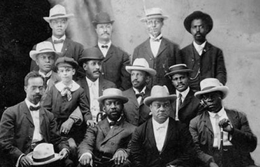
National Association for the Advancement of Colored People (NAACP) is founded
W. E. B. Du Bois is a co-founder of NAACP. Source
William Edward Burghardt (W. E. B.) Du Bois graduates from Harvard and is the first African American to earn a doctorate. He rises to national prominence as a leader of the Niagara Movement. A group of African-Americans who insist on full equal civil rights and political representation for Blacks. He and his supporters oppose the Atlanta compromise, an agreement crafted by Booker T. Washington which provides Southern Blacks work if they submit to White political rule, and Southern Whites guarantee that Blacks would receive basic educational and economic opportunities, see 1881.
Du Bois is troubled by why the White working class in the United States refuses to align with formerly enslaved Black Americans to challenge their common oppression.
He dies in 1963, one day before Mr. Luther King Jr speaks at the March on Washington.
1908
Vinton public school

1906
Carnegie unit is defined to set a standard to consider if students are prepared for college.
Henry Prichett is president of the Carnegie Foundation for the Advancement of Teaching. The foundation emphasizes the role of school as teaching content and recommends a definition of a unit as a course of five periods weekly through out an academic year with a period being about 55 minutes long, Carnegie unit. The trustees recommend that colleges require the completion of 14 units before admission.
U.S. Steel company opens a new plant in Gary Indiana and builds a city for its employees that include a new progressive school around the philosophy of learn by doing promoted by superintendent William Wirt's work-study-play program. Becomes known across the country as the Gary Plan or industrial plan and influences 1917 legislation.
1904

Daytona Normal and Industrial Institute is founded by Mary McLeod Bethune
Mary McLeod Bethune, an American educator, starts a private school for African-American students in Daytona Beach, Florida, which is now Bethune-Cookman University.
- Elected president of the American Teachers Association, 1924.
- Appointed director of African American Affairs by President Franklin Roosevelt, 1936.
- Founds the National Council of Negro Women, 1935.
1900
About 6% of adolescents complete high school and earn a diploma.
Native Americans and education
The Middle Five: Indian Boys at School is a first person narrative of the early education of Francis La Flesche (1857–1932) and four 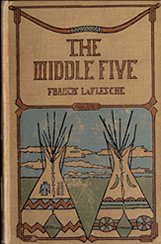 close classmates. 262 pages.
close classmates. 262 pages.
Born on the Omaha Reservation in northeast Nebraska he attends the Presbyterian Mission School for Indian children. The school is first located in Bellevue, Nebraska in 1845, then moves to the reservation in northeast Nebraska in 1857. The book is a series of stories that together document the abuse Indian children suffer in a reeducation curriculum and the antics of five boys as they unite to survive and grab fleeting moments of control when opportunities are presented.
Learning how to survive being away from family during the school week or longer. Being told their culture is for heathens and savages and best forgotten. Being required to only speak English and forbidden to speak their Omaha language, even young children, that knew no English, were punished when they spoke Omaha. Having their hair cut, native clothes taken away, sleeping in a dormitory three to a bed... Learning arithmetic, geography, history, and language to a fifth level reader.
Stories of being orally quizzed to show off for visitors. Participating in a spelling bee when a visitor requested it so he might present the winner the new spelling book used to give the words for the bee. Story of making sleds that were later stolen by Ponca boys, who they chased down so they might recover their sleds after a good fight. Mental math and problems related to their sled making, and much more. A moving story for those who seek to envision the difficulty in walking among two cultures and becoming educated with some of the best from both to not only survive, but prosper on their own terms.
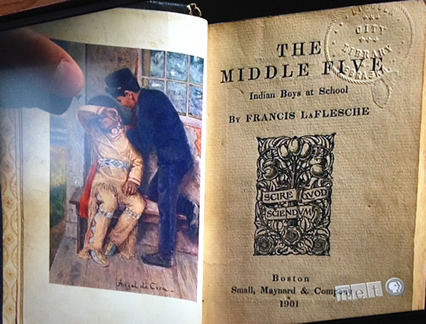
Later he attends George Washington University Law School in Washington, DC and earns undergraduate and master's degrees. He is the first Native American anthropologist. Works with the Smithsonian Institution, documents his Omaha and Osage culture. Works as a translator and researcher with anthropologist Alice C. Fletcher. Makes valuable original recordings of Native American songs and chants. Collaborates with composer Charles Wakefield Cadman to write the opera, Da O Ma starting in 1908 until it was performed in 1912. It is an opera, based on his stories of Omaha life. Source
His sister, Susette (Bright Eyes) La Flesche also attends the Mission school and is an interpreter for chief Standing Bear when he is on trial. Standing Bear v. George Crook See 1879. And when he is an expert witness on Indian issues and during his lecture tour of the eastern United States, 1879-1880. She is accompanied by her brother Francis who shares translation duties. Source She is also a journalist for the Omaha, NE World-Herald and The Independent newspaper in Lincoln, NE.
His half sister, Suzanne LaFlesche Picotte (1865–1915) begins her education at the Presbyterian Mission School. Then she attends the Elizabeth Institute for Young Ladies in Elizabeth, NJ and later the Hampton Institute in Virginia. After that Alice Fletcher, whom Susan cares for during an illness, and Dr. Martha M. Waldron, a physician at the Institute, helps her become the first person to receive federal aid for professional education by getting funds from the U.S. Office of Indian Affairs to attend the Women's Medical College of Pennsylvania. She graduates in 1889 at the top of her class and becomes the first female Native American doctor (Omaha). She practices medicine in Bancroft, NE and its surrounding communities. She also advocates for public health, Native American issues, and the legal allocation of land for members of the Omaha tribe. Source

More on How Susan and Rosalie La Flesche Made Omaha History read in the Smithsonian magazine
The Genoa Indian School, in Nebraska, enrolls 599 students from 40 Tribal Nations between 1884 and 1934. Source
- It includes 30 buildings on 640 acres.
- Education is based on a military model with classes on blacksmithing, carpentry, harness making, and tailoring for men.
- With women trained in culinary arts, sewing, nursing, and housekeeping.

By 1900, across the United States, 21,000 Native children attend similar residential schools, away from their families. Read, This Tender Land by William Kent Krueger, who wrote about four orphans who attend Lincoln Indian Training School in Minnesota.
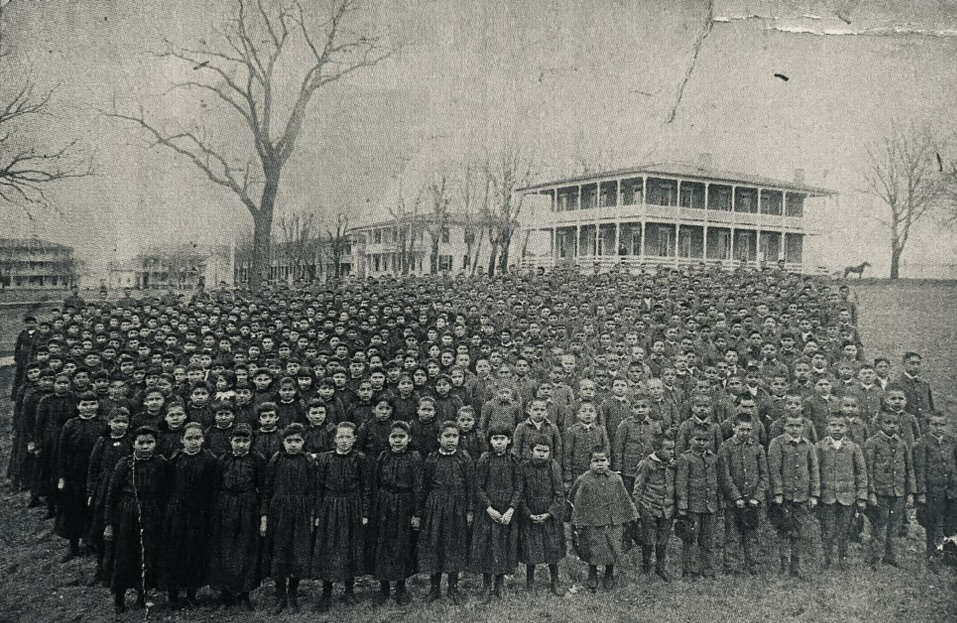
College Entrance Examination Board is established
1899
In Cummig v. Richmond County Board of Education the U.S. Supreme Court rules the school board did not violate the Constitution when it closed the only Black high school and kept the White high school open. The decision, based on Plessy v. Ferguson, claims it is reasonable that separate but equal could apply as the Black elementary school is kept open and since there is a small number of Black high school students, they could attend a Black school else where.
The first public school class for students with disabilities is established by Elizabeth Ferrell in New York City public schools is documented.
1898
1898 - The idea that teaching could be reduced to highly controllable methods.
See Skinner 1934.
1896
Plessy v. Ferguson
The Supreme Court rules, that separate rail cars for Black and White passengers did not violate the 14th Amendments and the equal protection clause is legal, as long as the difference is reasonable.
The separate but equal decision makes racial segregation legal and delays ruling equality as a universal standard.
The court attempts to establish a distinction between civil and social equality to justify White supremacy. And upholds the constitutionality of the Jim Crow laws. It holds until 1954 with Brown v. Board of Education of Topeka.
See more about Homer Plessy, Judge Ferguson and this case.
First lab school
John Dewey (1859-1952) as a Professor at the University of Chicago starts the first lab school to test progressive education techniques (1896).
- 1896 School and Society
- 1897 My Pedagogic Creed
- 1899, 1900 The School and Society lectures
- 1902 The Child and the Curriculum
- 1916 Democracy and Education: an introduction to the philosophy of education
- 1938 Experience and Education
Termed mis-educative experiences as that which has the effect of arresting or distorting the growth of further experience. Which is a barrier to freedom. 1938 Experience and Education pp 64-65
1895
The Atlanta Compromise
Booker T. Washington gives his Atlanta compromise speech in Atlanta. It enables him to rise to national prominence with support of the rich White upper class. The speech introduces his belief that Blacks should be patient, accept a working class existence, and avoid confrontation over Jim Crow segregation. He says Blacks should make progress through self-help, education, and entrepreneurship. He mobilizes a national coalition of middle-class Blacks, church leaders, White philanthropists and politicians around his ideology that Blacks should be educated as a working class, which he institutes at Tuskegee University, and does not seek equality with Whites.
W. E. B. Du Bois, at first supported the Atlanta compromise but after the founding of the NAACP in 1909 he challenges Booker T. Washington with a more demanding style of leadership for the Black community. It is years after B. T. Washington's death that the Civil Rights movement and the NAACP take a different stance.
1893
National Education Association's Committee of Ten
Chair Charles W. Eliot
Affirm the purpose of high school is to emphasize mental discipline through language, humanities, and science.
- The report includes answers to a set of eleven questions
- Outlines curricular knowledge for 1. Latin; 2. English; 3. Greek; 4. other modern languages; 5. mathematics; and 6. physics, astronomy, and chemistry; 7. Natural history (biology, botany, zoology, and physiology), 8. history, civil government, and political economy; 9. Geography (physical geography, geology, astronomy)
- Recommends 12 years of education, 8 - elementary and 4 - high school.
- Addresses tracking, or course differentiation based on postsecondary pursuit and unanimously states every subject should be taught in the same way and to the same extent to every pupil no matter what.
- Claims it [standardization] would promote equality in instruction.
- Claims this [standardization] would also simplify school instruction and training of new teachers
- Identifies a need for more highly qualified educators.
- Proposes universities enhance training by offering subject-education courses, and lowering tuition.
- Provide pay for classroom teachers, superintendents, principals or other leading teachers to show other teachers how to [teach] better.
- Democratize education and access to it.
Minority report focuses on considerations for deviation of the recommendations by local schools.
Source Report
Ellen G. White - Christian education and Seventh Day Adventist Church
She first writes educational essays in 1872 and then writes detailed descriptions for a Christian educational system in 1893, 1894 and 1903. Her writings include:
- Education is God's glorious purpose of the human race.
- Christian Education is essential for a healthy society.
- The most important factor in education is the parents.
- Parents early interactions with their child is critical.
- Teachers should teach with self control, patience, forbearance, gentleness and love.
- School should be a sanctuary.
- Education is necessary for the whole body, mind, and spirit.
- One needs to learn:
- To care for themself and the living environment.
- Respectful for self, others, & cultures.
- Education needs to be place based.
- Education should be practical.
- Job skills.
- Healthy living.
- Good vegetarian diet.
- Community living.
- Community service.
- That science teachs how God works.
Source Blueprint for Learning.
1892
The Committee on Secondary School Studies
by NEA (National Education Association)
Finds:
- The average length of a school term is 135 days with the average attendance per student being 86.
- High school curriculum is very similar to a college curriculum.
Recommends:
- A more standard curriculum to benefit students and provide a common academic background in preparation for university.
- Specific subjects to be taught: Latin, Greek, English, modern languages, mathematics, science, history, and geography.
- Leaves vocational education as an option, but desired subjects should be taught in the same manner and extent to every pupil no matter their intended educational goals.
- Claims secondary schools do not wholly exist for the purpose of preparing boys and girls for college, but to prepare them for the duties of life.
However, since preparation of students for college is considered important for the welfare of the nation. The main goal remains to prepare the small number of students who can achieve a college education and whose parents are able to support them. Which is further rationalized with the idea that the best preparation for college is also the best preparation for life.
However, the major objection of favoring a more practical education will over time chip away at the classical tradition curriculum, but the focus of secondary education remains college admission with the belief a focus on higher ed. is also preparation for life.
1890
Maria Montessori - (1870-1952) Italy
Montessori teaching method, is a child centered approach that allows and encourages students to freely interact with a real world kind of environment, provided by the teacher, for them to independently explore their interests. The teacher controls the environment to provide order and set limits. Students begin their learning by playing, which provides opportunities to develop social, emotional, and intellectual growth with real world concrete experiences to take initiative and become self-confident independent critical thinkers.
College entrance exam
Harvard President Charles William Eliot proposes a common entrance exam to be used by all colleges and professional schools in the U.S.
1888
Sod schoolhouse - Rural public school
Checkout some videos, books, & articles about Minnie Freeman and the blizzard of 1888. Wikipedia
1887
Adolf Kussamaul, German doctor
Uses the word: dyslexia to describe a very great difficulty in interpreting written or printed symbols.
Helen Keller meets Sullivan who will make a break through while teaching her.
1881
Tuskegee University - a dream of Lewis Adams.
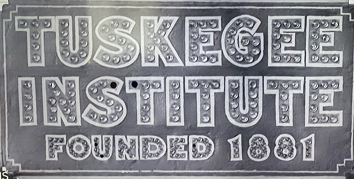
W. F. Foster, approaches Lewis Adams and asks him what he wants to help him turn out the African-American vote in Macon County for his re-election to the Alabama Senate. Adams answers: he wants an educational institution for his people. After elected Foster gets the legislature to appropriate $2,000 for teachers’ salaries and forms a board of commissioners to get the school organized. Members included: Lewis Adams, Thomas Dryer, and M. B. Swanson. George W. Campbell, who becames the second commissioner and selects Booker T. Washington from Hampton Institute as their first teacher. Source
See 1895 The Atlanta Compromise.



Classroom 1881
Source Library of congress
188o
The McCorkindale Schoolhouse - built in 1880
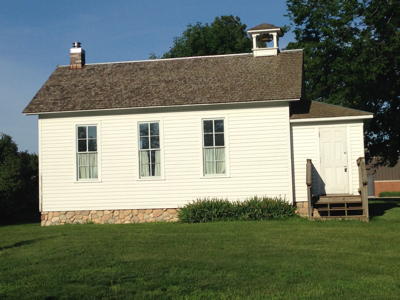
Presently located at Wayne State College, Wayne, Nebraska.
1879
Standing Bear v. George Crook, Native Americans are ruled persons
Presiding Judge Elmer Dundy of the US District Court in Omaha, NE (15th and Dodge?)
Standing Bear and other Ponca Indians are living; on their reservation in Niobrara, NE. Farming and sending their children to school before being removed and taken south to Indian Territory in Oklahoma. There crops do not grow and 158 people die. Among them his son. Honoring his son's wish, to be buried in his homeland, a small group head north and are captured on the Omaha reservation. They are brought to Omaha, NE where a writ of habeas corpus is filed at the court house at 15th and Dodge.
The case centers on: do Indians have a legal right to a writ of habeas corpus (a court order, that literally means to produce the body, or a court order to bring a person into the court room to decide if the person has been detained, jailed, or imprisoned legally). Standing Bear's attorneys argues the government has no justification to arrest and detain them. They claim the law is clear. It says nothing about being a citizen. It says only: any person or party has a legal right to apply for a writ.
The government's attorney argues the court overstepped its legal boundaries and has no legal right to compel the government to justify its arrest and relocation of the Indians, because an Indian has no legal right to sue in federal court. Further no writ has ever been issued for an Indian and can not be.
Dundy rules: It is illogical to assume that since no Indian ever sought a writ of habeas corpus, that Standing Bear could not seek one. The court has jurisdiction, because Standing Bear and the Ponca were restrained of their liberty in violation of a treaty provision and only the federal court can determine if the prisoners' constitutional rights were violated.
He writes:
"It would be a sad commentary on the justice and impartiality of our laws, to hold that Indians, though natives of our own country, cannot test the validity of an alleged illegal imprisonment."
As to who could legally apply for a writ. The government steadfastly argues only citizens could. And since Indians are not citizens, they could not sue. However, Dundy rules person not citizen is the required criteria and writes:
" ... a reasonable definition of a person can be found by consulting a dictionary.
"Webster describes a person as‚ a living soul; a self conscious being; a moral agent; especially a living human being; a man, woman or child; an individual of the human race."
This, he said, "is comprehensive enough, it would seem, to include even an Indian."
Dundy says, Standing Bear and the Ponca have done all they could to terminate their tribal allegiance (expatriate) to become independent farmers, provide education for their children, and adopt the ways of civilization.
He notes that on July 27, 1868, Congress declares the right of expatriation (to withdraw oneself from residence of one's native country) is a natural and inherent right of all people, indisputable to the enjoyment of the rights of life, liberty, and the pursuit of happiness.
All this leads Dundy to the decision:
"An Indian possesses the clear and God-given right to withdraw from his tribe and forever live away from it, as though it had no further existence."
Finally, does the government have a legal right to remove Standing Bear and the Ponca from the Omaha Reservation and send them back to the Oklahoma Indian Territory?
An Indian, “possesses the clear and God-given right to withdraw from his tribe and forever live away from it, as though it had no further existence.”
Finally, did the government have a legal right to remove Standing Bear and the Ponca from the Omaha Reservation and send them back to the southern Indian Territory?
Dundy writes, no such power exists. The government can not arbitrarily round up Indians who had severed their tribal ties and simply move them whenever and wherever it wanted. Unless, they were deemed detrimental to the peace and welfare of the reservation. But in such cases, the law requires they must be turned over to civilian's not military' authorities.
In summary, Judge Dundy concludes,
- An Indian is a PERSON within the meaning of the laws of the United States, and has therefore the right to sue out a writ of habeas corpus in a federal court.
- General Crook illegally detained the Ponca prisoners.
- The military has no legal authority to force removal of the Ponca to Indian Territory.
- Indians possess the inherent right of expatriation as well as the more fortunate White race, and have the inalienable right to life, liberty and the pursuit of happiness ...
- And, since they have been illegally detained in violation of their constitutional rights, the Ponca must be discharged from custody.
Judge Dundy does something unprecedented:
He grants the hearing and declares, for the first time in the nation's history, an Indian is a person within the meaning of U.S. law with legal rights Whites are required to uphold. Unfortunately, Judge Dundy does not address the issue of citizenship for Indians. It would not be until 1924 when Congress passes the Citizenship Act, which provides citizenship for all Indians.
1878
1877
First use of the idea of dyslexia
Adolf Kussamaul, German neurologist, uses the phrase, word blindness, to describe a person with complete text blindness in spite of being sighted, having intellect, and the powers of speech intact.
1875
First official college football game is played in New Jersey: Rutgers vs Princeton
1873
Kindergarten
Susan Blow travels to Germany where she observes classrooms inspired by the work of Friedrich Froebel. She watches young children learn language, math, and science through play. She returns to America and works to provide this kind of education to young children.
She opens the first kindergarten in September 1873 at Des Peres School in Carondelet within the Saint Louis School District.
Her kindergarten classroom is bright and cheerful with tables and benches and many plants, books, toys, balls, blocks, and other simple objects for children to use to play and learn about colors, shapes, language, numbers, and health issues about keeping clean, eating well, and getting regular exercise.
Source: State Historical Society of Missouri
- Margarethe Schurz, opens a kindergarten in Watertown, Wisconsin in 1856.
- Elizabeth Peabody, opens one in Boston in 1873.
- The National Education Association, supports kindergarten in 1872, and establishes a department of kindergarten instruction in 1884. Source
1870
Christmas is declared a federal holiday
1869
Modern public schools

1867
Nebraska State Education Association (NSEA) is founded in Brownsville, Nebraska on October 16, 1867. It is the oldest professional organization in Nebraska. At the time less than 40% of school aged children attended school.
1864
Rebecca Lee Crumpler becomes the first Black woman in the U. S. to earn a medical degree
- She was raised by an aunt in Pennsylvania
- Worked as a nurse and community healer
- Becomes a doctor
- Publishes, A Book of Medical Discourses: In Two Parts, in 1883.
It is part memoir and an effort to share both clinical advice and her experience as a Black woman physician.
In it she writes,
Having been reared by a kind aunt in Pennsylvania, whose usefulness with the sick was continually sought, I early conceived a liking for, and sought every opportunity to be in a position to relieve the sufferings of others.
- It is these kinds of experiences that inspired her to pursue a life as a doctor of medicine.
1862
Morrill Land Grant Acts 1859 - 1862
Congress passes the Morrill Land Grant Act in 1859. It allocates land to states based on the number of senators and representatives each state has in Congress to fund agricultural schools similar to Michigan State University at the time. However, it is vetoed by President James Buchanan.
In 1861, it is amended to include teaching of military tactics as well as engineering and agriculture. This change, and the fact some states that did not support it are now in the Confederacy, allos it to pass and is signed into law by President Abraham Lincoln in 1862. See later acts, The Smith–Lever Act of 1914 , Smith-Hughes Act 1917, and later G.I. Bill 1944.
1861
First Black teacher and school in Virginia
Mary Peake & Hampton Normal School
With the Union Army in control of Fort Monroe in Hampton, Virginia, Union Major General Benjamin Butler decrees any enslaved people who crosses into Union lines are contraband of war and would not be returned. This brought many enslaved people to the first self-contained African American community.
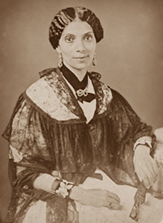 Mary Peake, a free Negro, is asked to teach the refugees, even though an 1831 Virginia law forbid the education of slaves, free Blacks and mulattoes. She teaches her first class, on September 17, 1861 under an oak tree, that will later be the site of the first Southern reading of the Emancipation Proclamation in 1863.
Mary Peake, a free Negro, is asked to teach the refugees, even though an 1831 Virginia law forbid the education of slaves, free Blacks and mulattoes. She teaches her first class, on September 17, 1861 under an oak tree, that will later be the site of the first Southern reading of the Emancipation Proclamation in 1863.
The Emancipation Oak still stands and is on the grounds of Hampton University.
Mary Peake's class evolves to became the Butler School for Negro children, where students are taught reading, writing, arithmetic, geography, and grammar, as well as various housekeeping skills. Then in 1868 The Hampton Normal and Agricultural Institute, which today is Hampton University, opens next to the Butler School.
The Butler School, is succeeded in 1889 by the Whittier School, which is a lab-school or teaching school for the Hampton Normal School.
Source and additional information about the history of Hampton University
1857
National Education Association
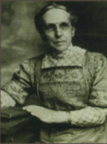
NEA is founded to professionalize teaching. Previously it is the National Teachers Association (NTA). Membership is limited to gentlemen and women are honorary members. However, Hannah Conrad and Agnes Beecher are included on the list of original members. In 1866 the constitution is ammended. Gentleman is changed to person.
In 1910 women reject nominations by the nomination committee and elect Ella Flagg Young as their first female president. Previously the first female superintendent of Chicago schools and Illinois Education Association president. Source NEA
See also 1937 Future Teachers of America
1855
Massachusetts is the first state legislature to pass a law banning segregated schools
Nebraska passes legislation to create free public schools
The act creates a territorial superintendent of schools and librarian who is to over see county superintendents who shall be elected by popular vote.
Superintendents shall divide their county into districts and notify their residents to organize their schools. Each county is to levy a tax between three and five mill on all taxable property in the county and distribute the revenue based on the number of White children between the ages of five and 22. A local school board, of three members for each district, shall organize and manage each district school.
The average building is about 22 x 32 feet and 12 feet high made with sides of rough logs and roof of sod. For a cost of about $1,000 furnished. However, most are built larger to use for public gatherings.
Superintendents certify teachers, but it is customary for local school boards to approve their proficiency in spelling, reading, writing, geography, history of the United States and English grammar … Salaries are about $30 for men and about $26 for women. Source
1854
The Ashmun Institute receives its charter from the Commonwealth of Pennsylvania on April 29, 1854
It is the nation's first degree-granting Historically Black College and University (HBCU). Located in southern Chester County in Pennsylvania. In 1866 it is renamed Lincoln University in honor of President Abraham Lincoln. The history of Lincoln University dates even earlier to 1794 when John Miller Dickey, and his wife, Sarah Emlen Cresson contribute to the education of African-Americans in Philadelphia. Source
1852
Compulsory education state law
In 1852 Massachusetts is the first state to pass a law for compulsory education. It requires every town to create and operate a grammar school. It also allows fines to be levied on parents who do not send their children to school and if they do not comply, they could be found unfit to properly educate their children, and their children could be taken and apprenticed.
Compulsory education laws are passed in other states until the last state, Mississippi, does in 1918.
Massachusetts originally enacts the first compulsory education law in the American colonies in 1647.
Early American education and its roots: 1776 - 1850
Summary of changes 1776 -1850
Education during this time is seen as the responsibility of the family.
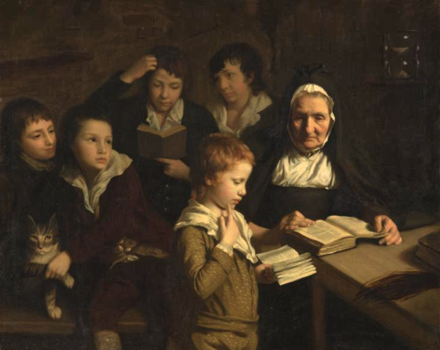
Cornish School Mistress
However, as more people want to educate their children they collectively organize to provide schooling. With one of their educational goals being to maintain a democracy for all rather than an elite minority, they begin to work through government to provide schooling.
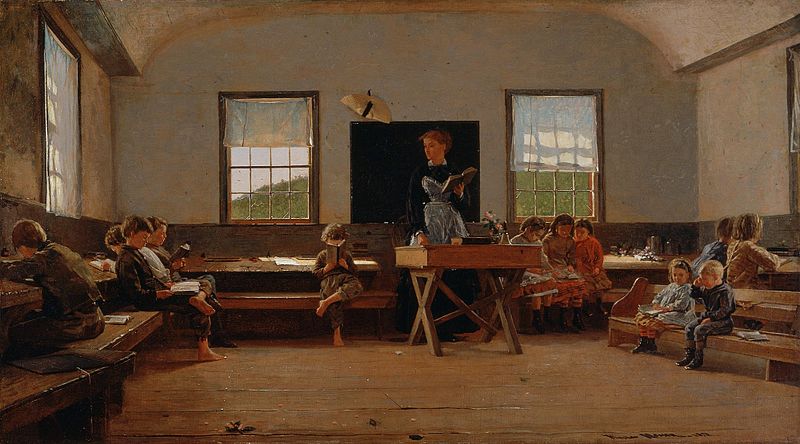
The Country School Winslow Homer
Thus, education becomes a governmental function seen as an important way to establish a capable citizenry to maintain a democracy. A citizenry composed of people beyond the sons of the elite affluent families or a few who are lucky and gifted enough to rise to the top (meritocracy). As to whether people understood majority as a simple majority or a majority more toward all with the inclusion of all diverse kinds of people is not fully defined and would lead to controversies in years to come.
Early American Education is also evolving from the influence of ideas brought to America and applied with an American flavor. Among them the exploration of universal education for larger numbers of children, education outside the home, increases in the percentage of girls and women being educated, funding of schools by cities and states, classical education, and large class sizes.
Most schools still have a strong religious influence and high ethical standards.
Curriculum is narrowing in a sense to reading, writing, and arithmetic in the younger grades and in the secondary preparation for college and university. Trades and agriculture are kept outside the curriculum and are learned from family members, apprenticeships, or on the job training.
Colleges and universities begin to increase in number and begin to alter their European medieval curriculum in ways to make it more American.
Curriculum includes traditional content in subjects or topics. Texts used for instruction are increasingly being written in English, as opposed to Latin and Greek. This creates a decline of the use of Latin in the classroom and requirements for Greek are removed, except for students who prepare for the ministry.
Other changes are the continual addition of seat time in school and the addition of courses such as natural science, trade, commerce, agriculture, and merchandise.
From 1790 - 1800 the use of syllogistic disputations at most colleges is reduced and the use of forensic debate increased.
1850
Roberts v. Boston - a case seeking to end racial discrimination in Boston public schools
Sarah C. Roberts, a five-year-old African-American girl, is enrolled in an underfunded all Black school. She is denied admission to the nearer Whites-only Smith school on the basis of her race, Her father writes to the state legislature for a solution.
The solution first involves the Massachusetts's Supreme Court, where Roberts asks for integration and is denied it in 1846.
Some African-Americans argue for integration and others argue for separate but equal schools. Some Blacks and Whites question the education their children would receive from integration. see Atlanta Compromise. While, others recognize, true equality can only be achieved through integration.
- In 1855 the issue is brought to the Massachusetts state legislature which writes and passes a law banning segregated schools. It is the first state law prohibiting segregated schools.
- Roberts appeals to the U.S. Supreme Court and it rules in favor of Boston, finding no constitutional basis for the suit. See Robert Morris lawyer, the first Black attorney to ever file a lawsuit in the United States, who argues this case.
- The Roberts v. Boston case is cited in both the Plessy v. Ferguson decision in 1896, which rules in favor of separate but equal; and in Brown v. Board of Board of Education decision in 1954, which rules against separate but equal.
Reformers push for new, clean, neat well kept buildings to educate productive caring citizens.
Without them they …
- Worry poor school facilities would supersede the school’s moral lessons, transforming students into thieves, midnight assassins, and incendiaries. 1853, Holbrook
- Believe big roomy, hygienic buildings in which the noblest of feelings of the human heart might be trained … instead of the ruthless disposition to destroy. 1856, Burrowes
- Run down schools corrupt children … neatness in the the furnishing induces or begets habits of neatness in the pupils and prevent future destruction. 1868, Freese
1848
Seneca Falls Declaration of Sentiments and Resolutions are written at the convention for woman's rights. held at Seneca Falls on July 19-20, 1848.
1844
The Philadelphia Riots (Prayer Riots, Bible Riots and Native American Riots)
They are several riots between May 6 and 8 and July 6 and 7, 1844, in Philadelphia, Pennsylvania and the adjacent districts of Kensington and Southwark. Thirteen people die, Catholic Irish churches are attacked and two burn to the ground.
A major issue is whose religious interest would be represented in school, not a separation of church and state issue. The city is divided by anti Catholic and a Nativists anti immigrant sentiments. The use of a protestant Bible in public schools, derogatory religious and heritage wording in other texts and language by the teachers spark the riots. Source
The seperation of church and state and it's desire for public money will continue. A cartoon in 1887 illustrates this with Pope Leo XIII below grapes labeled public school:
1843
Prussian / German influence
Prussia's defeat by Napoleon Bonaparte, 1806, motivates the government to implement sweeping educational reforms. King Frederick William III designs a system to create citizens who would obey and submit without question. It is a three tier design:
- 1/2% of students taught how to manage: materials, men, and situations.
- 5-8% of students, prepared as politicians, doctors, lawyers, & engineers.
- 92-94% of students, to learn to be obedient, cooperative, and have the correct attitudes, be literate, and know the official state fabricated history.
The purpose to make 95% of the citizens subservient to the ruling house and state. Source: Schools on Trial, Nikhil Goyal p. 43-44.
See 1873 kindergarten, 1837 Horace Mann
Elizabeth Barrett Browning writes the poem The Cry of the Children. to create greater support for child labor laws to remove children from suffering and dying in factories and other means of employment.
1841
Catharine Beecher advocates that public education needs women teachers
Catharine Beecher sees public school enrollment grow and the quality of teachers decrease. Her concern that children's moral, physical, and intellectual development might suffer, causes her to advocate for a greater role of women in education. She believes this would: improve public schools as women are natural teachers, provide opportunities for women to become better educated, provide women job opportunities, and met the increasing demand for teachers. She works toward these goals:
- 1821, becomes a schoolteacher.
- 1823, co-founds the Hartford Female Seminary, to train women to be mothers and teachers.
- 1829, publishes an essay on the importance of women as teachers, Suggestions Respecting Improvements in Education.
- 1830, moves west and campaigns for more schools and teachers on the Midwestern frontier.
- 1841, publishes, A Treatise on Domestic Economy. In it she stresses the importance of women's labor and claims a single woman could be a teacher and could choose not to marry.
- 1852, founds the American Woman's Educational Association to recruit and train teachers.
Unfortunately as more women become teachers, the social esteem for the teaching profession declines. However, with teaching being one of the few educational opportunities for women it provides many gifted teachers to the profession that in later years will seek different occupations, which some claim as a reason for a decline in American education.
1840
Great School's Debate of 1840
John Hughes, Bishop of New York, petitions the New York public schools to fund Catholic schools to offer proper religious training to their congregation's children. Religious instruction in public schools includes basic prayers and passages from the Protestant, King James Bible without commentary or interpretation, which he deems insufficient and inappropriate. He also complains about derogatory ethnic Irish passages in the textbooks. Much of his congregation is Irish immigrants.
- After a three day debate, his petition is rejected.
- However, legislation in 1842 declares no sectarian religious instruction is to be offered in public schools.
- A committee reviews textbooks for ethnic bias and removes offensive passages.
- The public response in 1843 is to elect a school board that rules: reading the Bible in class is not - sectarian.
- John Hughes creates Catholic Schools for Catholic children to attend, which result in the expansion of the parochial school systems in the U.S.
The inclusion of Bible reading in public schools persists across the U. S. until 1963 when the U. S. Supreme Court bans organized prayer in the schools. Source
1839
First public Normal schools
A normal school trains high school graduates to be teachers by teaching standards or norms, hence its name. Most such schools are now called teachers' colleges. In the United States and Canada they trained teachers to teach in primary school. In Europe they educated teachers for primary, secondary, and post-secondary levels.
In 1839, a public Normal School is established in Lexington, Massachusetts. It operates today as Bridgewater State University.
In 1685, Jean-Baptiste de La Salle, founds the Institute of the Brothers of the Christian Schools, in Reims, France. The first normal school.
1837
Horace Mann accepts the position as the first Secretary of Massachusetts School Board
Horace Mann ( 1796-1859) advocates for a free common school for all children. Paid with taxes from all citizens. Summary of his work, philosophy and policies:
"No one did more than he to establish in the minds of the American people the conception that education should be universal, non-sectarian, free, and that its aims should be social efficiency, civic virtue, and character, rather than mere learning or the advancement of sectarian ends." Public Education in the United States (1919) Ellwood P. Cubberley. p. 167.
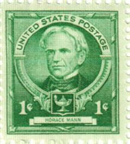
While Mann and others, at this time, want each student to develop their innate capabilities of a diverse self-culture, not job creation, but enlightenment. Some who follow later, see a bureaucratic system to create obedient productive workers.
Publicly funded schools are created and controlled by local and state government with a narrow New England Puritan centric curriculum.
While Secretary of education the state of Massachusetts, he:
- Advocates for common texts as a standard curriculum.
- Advocates for expertly trained teachers, high salaries, and improved curriculum and instruction.
- Establishes Normal Schools to regulate teacher preparation.
- Implements state collection of education data.
- Establishes state approved school libraries in each district, who were assigned the responsibility for the adoption of textbooks.
- Repeatedly refuses to condemn segregation of White and Black student in Boston.
Horace Mann suggests the purpose of collecting educational data [assessment]
- To evaluate the effectiveness of educational systems and programs to provide feedback to students and teachers.
- To measure student achievement in a manner that would equitably describe student's level of knowledge and skill and classify students for various purpose: one being certification, and
- To suggest reform to change and improve teaching and learning.
- And under his supervision Massachusetts is first to use standardized written examinations (1938). Source
Horace Mann is self educated by reading books he paid for by braiding straw. He Graduated Brown University. His valedictorian oration was The Gradual Advancement of the Human Species in Dignity and Happiness. He taught Latin and Greek at Brown, got a law degree, is elected to MA House, Senate, and then President of the Board of Education. The first in the United States.
Visited Germany and brought back ideas in 1843 that became the Prussian German Influence.
African Institute, later renamed Cheyney University (1914), is founded with support from Richard Humphreys to help young African Americans get a skilled trade. It offered basics in reading, writing, math, mechanics, and agriculture. Richard hoped a domino effect would be created as students from his Institute would spread education among other young, Blacks.
First Kindergarten.
In Germany Friedrich Froebel (1782 -1852) establishes the first kindergarten. He believes children need to play and interact socially with other children to learn. Therefore, his writings and practices for kindergarten are thought to be outrageous by many in German communities who believe children need more discipline and burn his book (The Education of Man).
See Kindergarten in U.S. 1873.
1836
Mc Guffy Readers.
William Holmes McGuffey publishes his first McGuffey Reader. Samuel Worcester and his publisher file suit for plagiarism. McGuffey removes all passages listed in the suit and republishes. McGuffy makes several revisions over the years that his readers are printed. Source and Samples
1831
A group of local citizens want to establish a college for African Americans in New Haven, Connecticut. Local residents vociferously condemn the Black College proposal, leading to its abandonment. This event was pivotal in the abolitionist movement, prompting the formation of the New England Anti-Slavery Society.
1827
The Commonwealth of Massachusetts
Passes a law that towns, of five hundred or more families, shall establish and maintain high schools with a ten month program.
1824
Johann Friedrich Herbart believes education should focus on moral character.
His writings include
- General Pedagogy, 1806
- General Practical Philosophy, 1808, and
- Psychology as a Science, 1824–25
In these, he argues morality is developed with experiences and social interactions; and that pedagogy should be a science that aims to develop a student's moral and intellectual growth.
University of Virginia is founded by Thomas Jefferson
1823
First training school for teachers
The first training school for teachers, Concord Academy, in the United States is founded in Concord, Vermont, by Samuel Read Hall. His, Lectures on School Keeping, published in 1829, is the first American instructional book for teachers. He is also involved with teacher education at Phillips Academy’s, Holmes-Plymouth Academy, and Craftsbury Academy. He establishes the American Institute of Instruction, the oldest educational organization in America.
See also 1839, first public Normal Schools
Public money for private schools
New York City gives public money to religious organizations (Catholic, Presbyterian , Quakers, Jewish, Methodist, Lutheran, Episcopalian, and Baptist) to use for non religious educational purposes. The Free School claims New York is the only city where religious schools receive common funds and petitions the Board of Alderman, “that our civil and religious rights are abridged and injuriously affected by the operation of the Common School System,” and payments should be stop. The board agrees and stops payments. Source
1822
First school west of the Missouri River
Col. Henry Leavenworth establishes a U. S. Army post at Fort Atkinson (west of the Missouri River in what's today Nebraska). On February 4, 1822 he orders school to start under the direction of Sergeant Mumford who teaches the rudiments of the three R’s. Source
1819
Federal funds are allocated for schools on Native American reservations.
1806
Mass instruction, monitorial system, peer tutoring
Mass instruction, peer tutoring, monitorial system, and mutual instruction is included in the Bell-Lancaster or Lancaster method. Named after the British educators who independently developed it, Dr Andrew Bell and Joseph Lancaster. It starts with a large open room with seating for thousands. It has a raise areas for a teacher with students seated on benches rising on auditorium style seating with least advanced learners at the front and advanced at the rear. Around the sides are learners who are teaching assistants, who act as peer tutors. It increases class size and decreases the cost of instruction. Lancaster's motto: He who teaches, learns. It is criticized by taking the teaching assistants or tutor away from their own learning. Reformers import it to America. DeWitt Clinton in New York, later to Philadelphia, and Washington D.C. It is soon declared a failure by parents, students and teachers.
Noah Webster publishes A Compendious Dictionary of the English Language, the first American dictionary. Today it is the Merriam-Webster Dictionary.
1801
Johann Heinrich Pestalozzi (1746 -1827) - writes
How Gertrude Educates Her Children
Johann presents as a series of letters to guide parents and teachers on his methods, which emphasize natural, holistic development through sensory experiences, emotional connections, and hands-on activities.
1783
Dickinson College and Benjamin Rush on education.
Dickinson College is named after John Dickinson, governor of Pennsylvania and leader in the American Revolution. However, it is Benjamin Rush who envisions it, wrote its charter, and works to get it approved by the Pennsylvania legislature on September 9, 1783, six days after the signing of the Treaty of Paris. Making it the first college created in the new nation. Previously, it was a grammar school in Carlisle, PA founded in 1773. Source
Benjamin Rush (1745-1813) is a strong supporter of education, especially for women. He believes education is essential for the prosperity and independence of the nation. He supports free schools in every town with a hundred or more families, to teach reading, writing, arithmetic, republicanism, and character to unite the country. While Rush advocates for women to be educated, however, his views do not rise to the level of gender equality. See more in Benjamin Rush and Women's Education: A Revolutionary's Disappointment, A Nation's Achievement by Jodi Campbell. See also Benjamin Rush's Views on Women's Education by Jean S. Straub.
First American spelling book by Noah Webster
Noah Webster is paid to write and publish his first speller. The first of a three part series:
- A Grammatical Institute of the English Language.
- A grammar and
- A reader.
His goal is to provide the country with a standard system for an American national language, pronunciations, spelling, and ideas to unify a national culture. Criticized for the wording of the title he revises and reprints it in 1787 with the new title, The American Spelling Book. It sells more than 15 million copies by 1837 while the U.S. population in 1840 is 17 million.
Noah believes Americans need their own national government, distinct from the rest of the world. Their own history, character, and Americanized language. He advocates to remove all English books and creates an American history and language. Therefore, his spellers have a nationalist tone and many non English spellings. It is the fore runner of the Noah Webster's dictionary See 1806.
1779
Bill for public education
As part of his work in revising the laws of Virginia during the late 1770s and early 1780s, Thomas Jefferson puts forth a bill that becomes one of his most enduring works on the subject of education: Bill 79, "A Bill for the More General Diffusion of Knowledge."
When presenting this bill he claims to insure public happiness, people who are endowed with genius and virtue must receive a liberal education, at the public's expense, so they may guard the sacred rights and liberties of their fellow citizens.
The Bill is presented in the Virginia House of Delegates in 1778 and 1780, but does not pass. James Madison presents the bill several more times while Jefferson is serving as Minister to France. In 1796 the Act to Establish Public Schools is passed.
Colonial Education and its roots: prior to 1776
Summary of changes prior 1776
Early periods of education are characterized by what each person, family, or parent feel is appropriate for them, their family, and children. They are free to determine how they and their children are educated within their particular economic situation. It would involve children modeling their parents or other adult or skilled person. Parents teaching their children and others within a household. Parents and families hire others as nannys, tutors, private teachers, or contract to teach them at home. Some send their kids to private lesson, private schools, apprenticeships, into indentured servitude, and are sold or forced into slavery.
Three famous Americans apprentices: Ben Franklin printer. George Washington mason surveyor. Paul Revere silversmith.
As populations grow families began to collaborate and meet at churches, libraries, community centers, museums, informal day care centers or dame schools to provide basic literacy and numeracy skills in an affordable way. These are more like individual and small group lessons than school. Schooling experiences and advanced learning is very limited and thought necessary for only a few.
Schooling focuses on reading with initial instruction beginning with a Hornbook, to teach letters. Hornbooks are first used in England as early as 1450. Much education is centered around religion and high ethical standards. There is no standard primary or secondary curriculum which results in a diversity of study related to agriculture, military, trades, scholars, and religious sects. Often a book or list of books is used as the curriculum, usually classical authors. Early Americans, Adams, Jefferson, and Franklin have lists of recommended books along with other recommendations for learning that can be found in their writings they send to their children and other acquaintances.
Colleges and universities begin to appear and use a European medieval curriculum. Attendance is limited to White males who could afford to support the use of their time in study or those who are talented toward this type of learning, motivated to learn, and lucky enough to attain financial support privately and or in a few cases publicly.
Curriculum includes content in subjects or topics such as: Latin and Greek composition, classical literature, rhetorical studies, logic, ethics, philosophy, criticism, classical readings followed by original orations and writings based on classical models, arithmetic, algebra, geometry, logarithms. Later sciences (chemistry, botany, astronomy), history, geography, natural and civil law, civil history, laws and government, politics, trade, commerce, agriculture, merchandise, and modern foreign languages are added to the curriculum.
Instructional methods include: reading, lecture, recitation, translation of text, syllogistic disputations and declamations. Disputation is an academic exercise in oral defense of a thesis by discussion or debate using formal logic. Sample Declamations are students interpretations of famous speeches they re-give to demonstrate their ability to understand and apply the purpose and power of the speech and skill in public speaking. Samples
Tutors are hired to teach one or a small number of students in several areas who are later tested by the college president or select members of the educational community to see if they are ready to be admitted, move from course to course or advance to the next year, and ready to graduate. Tutors are replaced with faculty who are assigned to teach specific subject areas. At Harvard the first appointment is in 1722 in religion with other subject areas added until 1766 when the tutorial system is abolished and professors and tutors are assigned subjects rather than classes of students to prepare in all areas.
Trades are seen, not only as important to learn a trade, but could be important for all of society as noted by: Ben Franklin …
a proper education for all boys should be “suffer’d to spend some time at shops of artificers observing their manner of working.
1766
The tutorial system of one person instructing one person or a small group of students in all areas is abolished at Harvard and professors and tutors are assigned subjects rather than classes.
1765
John Morgan and William Shippen, Jr. founded the first medical school in North America
The Medical School of the College of Philadelphia.
The History of Little Goodie Two Shoes, or The Renowned History of Little Goody Two Shoes, Otherwise Called Mrs. Margery Two Shoes, is the first novel written for children, by Oliver Goldsmith who told the story of a virtuous and clever child, Margery Meanwell.
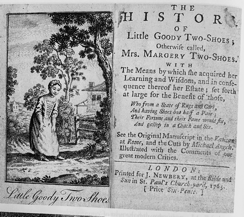
This history is a realistic depiction of rural education in England that describes teaching young children, illiterate adolescents, and adults who mke up the underclass.
1762
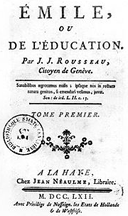 Jean-Jacques Rousseau (1712 -1778) Romanticist, Maturationist, and writer writes: Emile or a Treatise on Education.
Jean-Jacques Rousseau (1712 -1778) Romanticist, Maturationist, and writer writes: Emile or a Treatise on Education.
It is considered the first educational philosophy book as well as the first child psychology book. Thus, Rousseau is sometimes referred to as the father of modern child psychology.
Rousseau claims children have a natural goodness and can become critical life long learners and educated citizens by developing naturally at their own pace, and by exploring the world on their terms, if they could survive a corrupted society. These ideas lead to child labor being seen as exploitation instead of a form of moral education and protection from idleness and laziness.
From his ideas two philosophical learning theories or educational philosophies emerge.
Maturationist theory based on the idea learning comes from within each child. It can be thought of as genetically determined and naturally unfolding as each child grows by exploring the world in their own time and ways. Rousseau and others would disagree over the amount of predetermined, innate, inherited, genetic influence there is; as opposed to the amount of environmental or external influence.
Romanticism theory based on the idea the inner good will dominate over the inner bad. The child is like a plant who will grow according to the genetic information provided in the seed. A good or bad environment to nourish it will maximize or retard its growth. xs
1754
Anthony Benezet creates the first public girls' school and first School for Black children in Philadelphia
Anthony Benezet began teaching in 1739. In 1742, he moves to the Friends' English School of Philadelphia (now the William Penn Charter School) and in 1750 begins teaching night classes there for Black slaves.
In 1754, he left the Friends' English School and begins the first public girls' school on the American continent. Students include Deborah Norris and Sally Wister.
In 1770, he founds the Negro School at Philadelphia for Black children. Abigail Hopper Gibbons teaches there.
He also founds the first anti-slavery society, the Society for the Relief of Free Negroes Unlawfully Held in Bondage. After his death in 1784, Benjamin Franklin and Dr. Benjamin Rush reconstituted this association as the Pennsylvania Society for Promoting the Abolition of Slavery.
1751
The College of Philadelphia (later the University of Pennsylvania)
The College of Philadelphia begins college prep in 1751. It is believed to be the first curriculum that develops a curriculum that is not based on the traditional medieval curriculum and without religious objectives.
In 1752 William Smith publishes A General Idea of the College of Mirania.
He sends a copy to Franklin, who is impressed so in May 1754 Smith is appointed to teach logic, rhetoric, ethics, and natural philosophy at the College of Philadelphia.
In March 1755 he is made provost. While this curriculum has subjects similar to those of Harvard, Yale, and Princeton there is a different emphasis. A three year program of study with the first year of Latin and Greek composition; arithmetic, algebra, geometry, and logarithms; and classical and rhetorical studies. The second year includes more mathematics, logic and ethics, and added natural philosophy and classical readings followed by original orations written using classical models. The third year includes natural and civil law, civil history, laws and government, trade and commerce, and more natural philosophy. Emphasis is one-third classics, one-third mathematics and science, and one-third logic, ethics, metaphysics and oratory. The new emphasis continues with syllogistic disputations and declamations as an instructional method and for student assessment.
1749
First women doctor in the United States
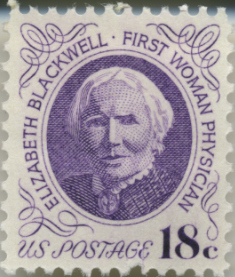
 Elizabeth Blackwell becomes the first woman physician in the United States. Her sister, Emily Blackwell, becomes the second. Together the sisters open the New York Infirmary for Indigent Women and Children, the first hospital with an all women staff.
Elizabeth Blackwell becomes the first woman physician in the United States. Her sister, Emily Blackwell, becomes the second. Together the sisters open the New York Infirmary for Indigent Women and Children, the first hospital with an all women staff.
- They add a Women’s Medical College with a rigorous progressive curriculum.
- Elizabeth writes, lectures, and promotes medical education specifically for women.
- Emily becomes a very qualified: obstetrician, gynecologist, surgeon and also professor.
- Read more in The Doctors Blackwell.

Benjamin Franklin helps open the The Philadelphia Academy and Charitable School or
The Academy and College of Philadelphia
This may have been the first American academy. In 1749 Benjamin Franklin draws up its constitution and is appointed its first president. It opens as a secondary school on August 1751, is granted a charter in 1755, and graduates its first class, seven men, in May 1757.
It is a secondary school to prepare people for life or to enter business and other vocations. Students study English, instead of Latin, the classics, modern language, and science. Secondary schools became popular, because they provide preparation for university cheaper than hiring tutors. Academies are sported by endowments, tuition, and in some cases state governments. Academies fill a need until compulsory public education becomes the norm. See 1852.
1749 - 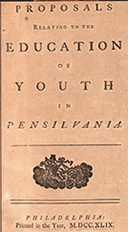 Benjamin Franklin wrote a pamphlet titled: Proposals Related to the Education of Youth in Pennsylvania in it he offers hints of a Plan for the Education of the Youth of Pennsylvania. The link above has facsimile of the original and electronic full text. This document describes what Franklin and other learned people of the time are thinking about the importance of education for the collective good. The exert below characterizes their educational philosophy.
Benjamin Franklin wrote a pamphlet titled: Proposals Related to the Education of Youth in Pennsylvania in it he offers hints of a Plan for the Education of the Youth of Pennsylvania. The link above has facsimile of the original and electronic full text. This document describes what Franklin and other learned people of the time are thinking about the importance of education for the collective good. The exert below characterizes their educational philosophy.
... "THAT some Persons of Leisure and publick Spirit, apply for a CHARTER, by which they may be incorporated, with Power to erect an ACADEMY for the Education of Youth, to govern the same, provide Masters, make Rules, receive Donations, purchase Lands, &c. and to add to their Number, from Time to Time such other Persons as they shall judge suitable.
That the Members of the Corporation make it their Pleasure, and in some Degree their Business, to visit the Academy often, encourage and (* 2) countenance the Youth, countenance and assist the Masters, and by all Means in their Power advance the Usefulness and Reputation of the Design; that they look on the Students as in some Sort their Children, treat them with Familiarity and Affection, and when they have behav'd well, and gone through their Studies, and are to enter the World, zealously unite, and make all the Interest that can be made to establish them (* 3), whether in Business, Offices, Marriages, or any other Thing for their Advantage, preferably to all other Persons whatsoever even of equal Merit. And if Men may, and frequently do, catch such a Taste for cultivating Flowers, Planting, Grafting, Inoculating, and the like, as to despise all other Amusements for their Sake, why may not we expect they should acquire a Relish for that more useful Culture of young Minds. Thompson says, "
1744
Pamela tells a nursery tale by Joseph Highmore
An example of how parens of means educate their children.
Early school for girls in New Orleans
Eight women convert a house to a convent school to educate girls of all races and classes in the French quarters of New Orleans, Louisiana. The group later builds the Ursuline Convent that relocates multiple times over the years. In 1729 they take in 30 orphan Natchez Indian girls. Over the years they are willing to educate all races, classes and free or slave. Being catholic and female creates special problems for colonial and later times as they work to achieve their mission. Source
1722
Benjamin Franklin, who never attended college, visits Harvard
Later, he writes. [Harvard as] "the Temple of Learning, where, for want of a suitable Genius, ... [students] learn little more than how to carry themselves handsomely, and enter a Room genteely, (which might as well be acquir'd at a Dancing-School,) and from whence they return, after Abundance of Trouble and Charge, as great Blockheads as ever, only more proud and self-conceited." Source
Later he opens his academy.
1713
Dame schools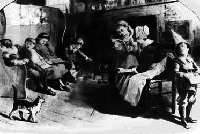
Dame schools are usually in the homes of the women (dames) who teach the children. The curriculum is letter & number recognition, reading & writing simple words, and memorization of prayers. Similar to many preschools from 1950-2015.
Etching at right is from 1713.
1704
First American school for slaves and Native Americans in NYC
Elias Neau asks and receives support from the Church of England and the Society for the Propagation of the Gospel to open a school for slaves and Native Americans in New York City. A 1764 report states:
“not a single Black” instructed and baptized through the school “had turned out badly or in any way disgraced his profession.”
This encourages additional support for schools assisting African Americans and Indigenous people in other places.
1689
John Locke wrote An Essay Concerning Human Understanding. The book is divided into four parts. The following are some key ideas presented.
- Argues humans are born without innate ideas already in their mind.
- Argues everything in our mind is one of two types of ideas: Sensory ideas or ideas create by the mind with its own operations.
- Presents a philosophy of language. Language of words that do not refer to things in the world but to the ideas in our heads formed in general terms from specific objects of the world.
- Presents his theory of knowledge. Knowledge as the perception of internal relationships among the minds ideas. Relationships such as: identity, diversity, relations, coexistence, and actual existence. All which exist at three levels.
- Intuitive, which he claims is self-evident and at the top. Examples: Something is either present or absent. Two is more than three. Black is not White.
- Demonstrative is created with reason and is in the middle. Examples: Two apples in one hand and three apples in another hand equals five apples. A feather fall slower than a coin, because air slows it. and
- Sensitive knowledge is that which comes from our senses and is at a lower level more of a pseudo- knowledge. Illusions can trick us. Smell like a rose, but is it a candle, perfume, shampoo? Water or a mirage?
Look into his book Some Thoughts Concerning Education (1693).
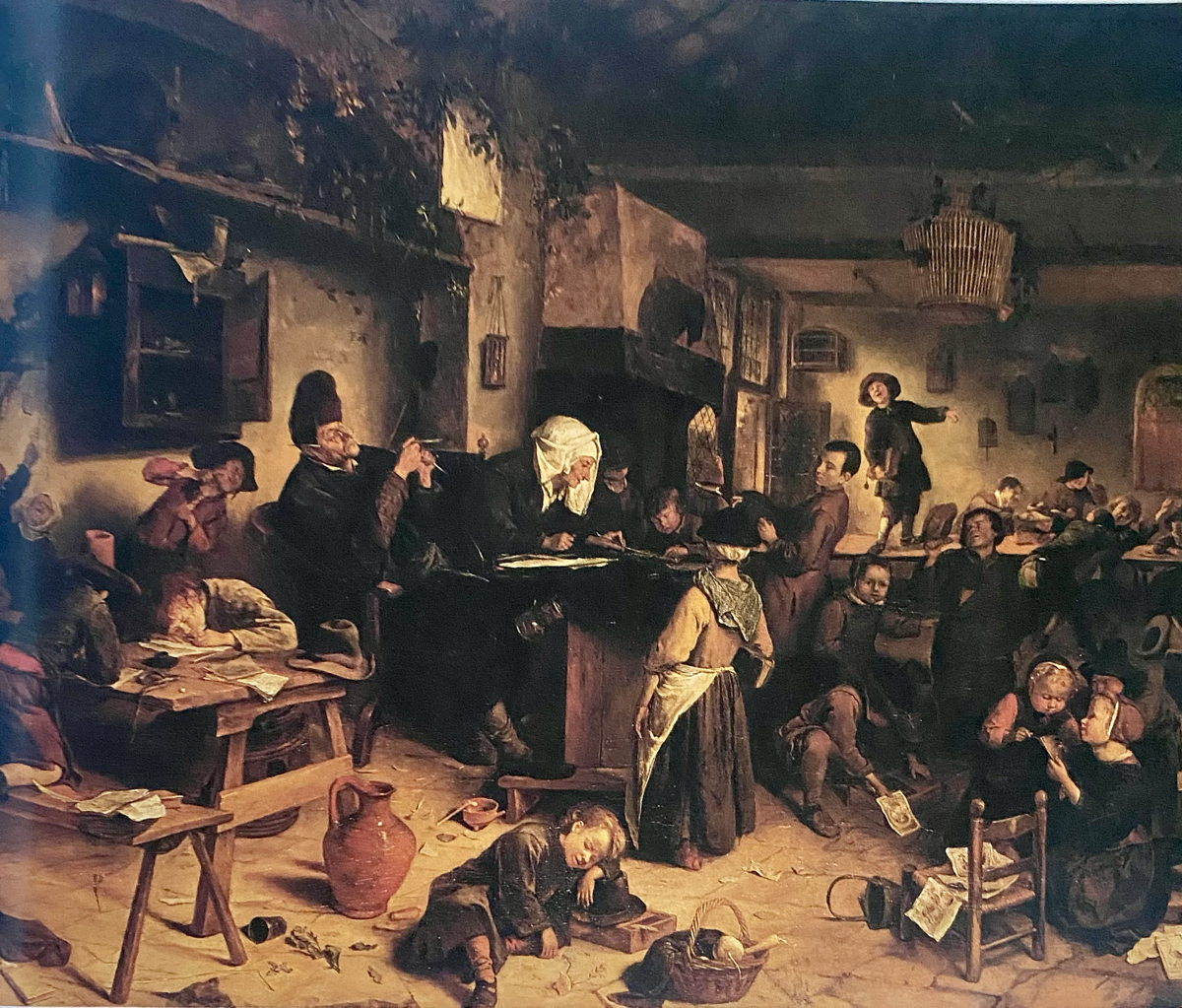
1650
John Evelyn and William Petty publish compileda description of the trades in History of Arts Illiberal and Mechanical
In it Petty explains ...
bare words are not sufficient, all instrument and tools must be pictured, and color added, when the descriptions cannot be made intelligible without them.
Thomas Sprat added, histories of trade would encourage the invention of improvements by members of the society.
1648
John Amos Comenius, Czech Jan Ámos Komenský, (1592,-1670,), Czech educational reformer flees the Thirty Years’ War and goes to Poland. There he plans how to rebuild his homeland, after the war, through educational reform.
He advocates: all children should attend school full time, be taught the Czech, and European culture, with efficient methods that are natural and centered on the way children learn, which he describes in his books: The Great Didactic (for educators) and The School of Infancy (for mothers).
To make the European culture accessible to all students, he believes it is necessary to learn Latin. However, he doesn’t like the present grammar rule based instructional method and advocates for a natural way to learn it. He writes textbooks, Janua Linguarum Reserata that presents facts about the world, side by side, in Latin and Czech. A language teaching revolution at the time. His book is translated into 16 languages. Source
1647
The Massachusetts Act of 1647 or the Old Deluder, Satan Act
Mandates each town, with fifty families or more, establish a grammar school, where a master shall instruct youth to be fitted for university. It is referred to as the Old Deluder, Satan Act because education is seen as protection against the devil, whose purpose is to keep men from the knowledge of the scriptures. Made towns responsible for educational facilities.
1642
The Massachusetts Act of 1642
Requires each town to determine whether its young people could read or write. If children are determined as not being able to read, have knowledge of the Capital Laws, instruction in religion and generally brought up to be able to achieve higher employment. Parents and people with apprentices, who did not meet the standards, could be fined or even lose custody of their children. Makes parents responsible for their children's education. Source
1638
First printing press in the American Colonies is assembled at Harvard College.
1636 , 1723
Harvard University first named New College
Harvard University, the oldest institution of higher education in the United States, is founded in 1636. The oldest institution of higher education in the United States with its mission to train clergy. Harvard receives its official name on March 13, 1639, when John Harvard donates half of his estate and his library of over 400 books. .. see also 1209 Cambridge...
Harvard curriculum (1636) is designed as a four year program of study. However, it is initially reduced to three years because of poor selection of its first master and withdrawal of students as a result of his tyrannical teaching methods.
The curriculum includes logic as a basic subject necessary for disciplined thinking, divinity, history and the nature of plants taught in the first year. Rhetoric (effective persuasive speaking or writing) and other compositional techniques are studied by reading a collection of literary pieces which students critique and give two speeches in Latin and Greek before small groups weekly and also monthly before the entire school. Students translated the Old and New Testament from Hebrew into Greek at daily prayer services. Arithmetic, geometry, astronomy, politics and ethics in the later year curriculum. However, politics is Aristotle's Politica and ethics is a practical subject, separate from religion. Instructional methodology follows the advice of Pierre de La Ramee that students should listen to a lecture on each subject, followed by individual study, recitation, discussion, and disputation. In 1655, the first year is expanded to two years with more Greek, Hebrew, logic, and metaphysics returning to the originally plan of four years.
M.A. degree is a three year post-graduate program of individual study with no residence requirement. Study is guided by a minister. A sermon presented to the student body and a written synopsis or compendium of logic is required. Natural philosophy, moral philosophy, arithmetic, geometry or astronomy are studied and presented problems three times and twice had to present a solution in a rhetorical speech before the society. However, flexibility seems to have been allowed in permitting other activities as substitutes.
Curriculum in 1723:
- Freshman year curriculum is a review of Latin and Greek grammar, a beginning study of Hebrew, and logic.
- Sophomore curriculum includes a continued study of logic, classical literature, and beginning to study natural philosophy.
- Junior curriculum added ethics, geography, and metaphysics with more natural philosophy.
- Senior curriculum added arithmetic, geometry, and astronomy.
1635
First Latin Grammar school in Boston opens
Latin grammar school curriculum is meant for the class of people who will become leaders of religion and government. Clergy, ministers, governors, mayors, lawyers, judges, and other learned men.
1620
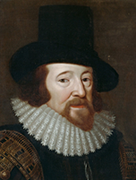
Sir Francis Bacon (1561-1626) publishes his Novum Organum, where he describes a system of logic he believes is superior to Aristotle's syllogism (360 BCE ) or deductive reasoning. It becomes known as the Baconian method, inductive reasoning and the scientific method
- Publishes Novum Organum, where he describes a system of logic he believes is superior to Aristotle's syllogism (360 BCE ) or deductive reasoning. It becomes known as the Baconian method, inductive reasoning, and the scientific method. Bacon may have been inspired by Ibn al-Haytham's Optics (Kitab al-manazir).
- He believes this new logic is the best way to draw conclusions about the natural world. An inductive approach of skeptical observation and experimentation with facts and explanations leading to conclusions. Because of this he has been called the father of empiricism and the father of the scientific method.
- Bacon asks for a writing of a history of trades to serve as a foundation of his new science.
- In 1624 he plans for Salomon’s House (a research center) where different groups of people can decide, at different points of time, what to research and what to develop. For example, what experiments to discover the true nature of things, what discoveries are valid, how to use them, what are best practice for man’s life and knowledge, and how to deliver to the public the stuff of progress.
- In 1620 he calls for a series of natural histories of trades to describe tools, techniques, and processes to enhance the greatness of man through new and practical science.
Pilgrims land on Plymouth Rock
Their religious views, ethics, and ideas on education will dominate education in the New England colonies and influence American Education.
1580
Bernard Palsy writes Discourse Admirable
In it he invites scholars to his workshop to see theories of many philosophers, even the most ancient and famous ones, to point out that many are erroneous in many ways.
1561
Elizabethan statutes of 1561
Requires each student be proficient in rhetoric, logic, and philosophy, and to be tested in them by public disputations before earning a degree. This includes the seven liberal arts: the trivium of grammar, rhetoric, logic; and the quadrivium of arithmetic, geometry, astronomy, and music (see 55 CE). With the three philosophies: natural, moral, mental added in the later years. Instruction is by tutor, who is responsible for four or five students.
Henry VIII believes citizens should be educated to govern well. And to do so they need to speak well, reason well, practice moderation and balance, and be suffused with humanity in all its senses: including how real human stories played out in the past.
As such, he educates his daughters, as he expects them to play a political role and have a moral responsibility.
- Mary is tutored by Juan Luis Vives and
- Elizabeth by Roger Ascham
1466 -1536
Desiderius Erasmus -
1245
Thomas Aquinas -
1229
First recorded student protests at the University of Paris leads to the school being closed for two plus years.
1209
Cambridge is found by a group of scholars who leave the University of Oxford after a dispute with the towns people. It is the second oldest English-speaking universities and the fourth-oldest university in the world that is still operating.
1284 Cambridge curriculum is to perfect the student's knowledge of Latin and Greek, introduce him to the method of scholasticism, and respect of the authority of the ancients. There was no prescribed course of study other than attendance of public lectures for three years, study theology, Old Testament languages, Hebrew, participate in disputations, and, give three personal opposing responses.
780
The birth of a common culture of education
Charlemagne (Charles the Great or Charles I) recognizes unity can be achieved through a common culture. A culture centralized with a strong central government (becomes the Holy Roman Empire) that uses religion and education to achieve this unity.
He creates a more fair rule of law empire, fuller participation of the church in the daily life of the people, encourages a common language by making Latin the official language of the state, and develops education for all citizens.
To achieve his educational goals, Charlemagne recruites teachers from England and Ireland. Alcuin (732–804) of Britain, is recruited to be head of the palace school. He develops programs to bring literacy to European clergy and their followers. As head he becomes very influential in promoting scholarship and the founding of a library in York. Many of his students go on to staff schools across Europe at all levels and many people benefit by their educated minds and the quality curriculum they bring with them.
- Charlemagne and Alcuin realize shared learning is part of a shared culture and their abilities to implement their ideas across a diverse population unite much of Europe and create the Holy Roman Empire.
- Insists on education for his daughters.
- A curriculum of three basic subjects (trivium) of grammar, rhetoric, and logic is their core and becomes the curriculum of secular knowledge for liberal arts universities.
- Their curriculum evolves and expands over the years after Charlemagne and Alcuin. By the 12th century, it includes seven subjects: the trivium and a quadrivium, consisting of arithmetic, music, geometry, and astronomy.
- Develops a new more legible script to make scribe’s texts easier to read - Carolingian or Caroline Minuscule.
374
Saint Augustine
354 - 430 philosophy of education - learners must be aroused by the teacher to discover that which they already hold within themselves.
55
Quintilian 35 - 95
Institution oratoria is the model used to educate an ideal citizen as an orator. The curriculum of the Trivium and the Quadrivium is used in schools and universities into the 1900's. Trivium included: grammar, rhetoric, and logic; and the quadrivium included: arithmetic, geometry, astronomy, and music.
C. E. -------------------- B. C. E.
220 BCE
World's first university
Ahvaz Jundishapur University of Medical Sciences in Khozettan, Iran is started.
323 BCE
Greek Hellenistic education goal is to prepare free adult males with sound minds and sound bodies (mental & physical abilities) to make sense of the world and be good citizens. Humanism explores the nature of the world with humans at the center. Later in Latin humanitas means a cultured free man. Much later becomes humanistic education.
Education to make an educated adult. It is not child centered as suggested by Rouseau in Emile. Everyday Greek education and later Roman education is the responsibility of a pedagogue: male nanny, often a trusted slave, who cares for a child and nurtures them to learn how to behave in life and inspire them to learn for life. Source As well as taking them to a teacher to teach literacy, rhetoric, reasoning, and ethics.
360 BCE
Aristotle - 380 - 322 BCE
Continued with teaching of rhetoric and added syllogism, use of logic as a device for determining the truth. (Categorical syllogism uses two premises and a conclusion: All humans are vertebrates; no insect is a vertebrate; therefore no humans are insects.
He teaches:
- Education should be controlled by the State.
- People learn to be virtuous with practice.
- Ethics, involves performing just acts.
- Learning becomes doing or acting.
- If what is being done is virtuous, then learning is intrinsically valuable for the individual and society: the State.
He argues:
- All citizens should participate in a Democracy. Therefore, a welfare state is necessary so all people live out of poverty and can contribute to the government.
- In Politics: some people should rule and others should be ruled is not only necessary, but expedient. All relations are relations of hierarchy: man rules over animals, men over women, masters over slaves. Slavery was not a matter of law but a matter of nature. Those who are by nature possessions are those who have a lesser capacity for reason ... better for them to be slaves and under the rule of a master. Reasoning used to justify slavery into the 1800's.
- If what is being done is virtuous, then learning is intrinsically valuable for the individual and society - the State.
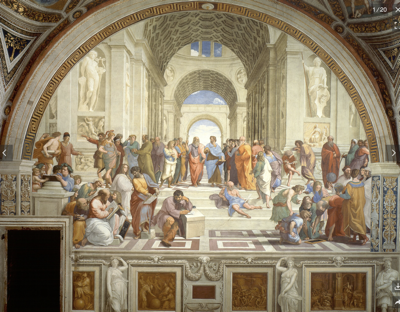
407 BCE
Plato and Socrates 347 - 427 BCE
Plato
- Plato & education - Source
- Plato suggests education is a public concern. That children, both boys and girls, should be educated to become virtuous well rounded citizens who are concerned for the well-being of human society. However, Greek schools are private and mostly for boys.
- Curriculum includes learning to read, write, count, and study of the poets: art, music, and literature for learners to develop their abilities to the fullest, which will achieve philosophic truth, for both individual justice and social justice.
- Starts The Academy in 387 BC, the first institution of higher learning in Greece. Its mission is for its students to achieve philosophic truth by question and answer; argumentation, and discussion. It continues until it is dissolved by Justin in 529 A.D.
- Plato suggests education is a public concern. That children, both boys and girls, should be educated to become virtuous well rounded citizens who are concerned for the well-being of human society. However, Greek schools are private and mostly for boys.
- Plato & reality
- He rejects relativism on the basis that if each person can determine reality, then nothing is infallible. He claims this is false logic. Reasoning, if a person thinks relativism is false, then according to Protagoras, it is their reality and it would be true. Therefore, if relativism is true, it must be false. Think on that ...
- Logically and practically this means for people to be able to cooperate and make progress they must agree on a common knowledge (truth).
Socrates
- Socrates develops a philosophy of education - learning happens when the teacher asks key questions. Socratic Method. Source The Republic. Key beliefs and ideas.
- Education is based on interests, abilities, and stations in life.
- Utopian ideal is to produce philosopher kings or guardians to rule the State.
- Built on Greek rhetoric: the art and process of effective public speaking. First taught by the sophists (480 BCE).
- Dialectic reasoning or dialectics (Socratic method, Hindu, Buddhist, Medieval, Hegelian dialectics, Marxist, Talmudic, and Neo-orthodoxy), and modern debate. All involve conversations between two or more people arguing different points of view for the purpose of establishing truth with reasoned argument.
- Socrates values truth as the highest value. Truth discovered through conversation with reason and logic (dialectic reasoning). Logic, not emotion, to discover truth for persuasion and make choices to guide one's life. To Socrates, truth, not art, is the greater good to guide one's life. Therefore, Socrates opposes the sophists and their teaching of rhetoric as art and as emotional oratory requiring neither logic nor proof.
- Dialectic method, rhetoric, and debate can have fundamental differences. In theory debate may be considered as unemotional and committed to rational argument. However, in practice debaters can present emotionally charged ideas to suppress rational thought, hoping to persuade others to their point of view. See rhetoric (480 BCE) and sophists
480 BCE
Sophists - 480 - 390 BCE
In the Greek world Sophists are wise men who teach by example: skills of civic life and explore a wide range of human experiences about Greek culture. Not being Athenians, they often clash culturally and philosophically with Athenians. Among them is Protagoras
- Sophists are the first teachers of rhetoric (an art, arte, and process of effective public speaking).
Rhetoric
A method or art of speaking or discourse/ conversation to persuade, inform, or motivate an audience. Concepts of rhetoric include:
- Pathos appeals to emotions and feelings (fear, anger, joy rest). The words sympathy and empathy are derived from pathos.
- Example - You should get vaccinated or you may end up like like Kevin and Misty Mitchem. An unvaccinated couple from Virginia who tragically died fifteen days apart, died and left their four children orphans.
- Ethos appeal through character and credibility. The word ethics is derived from ethos.
- Example - I am a doctor who has been studied vaccinations for years. I know it is safe, I get vacinated, and you should get vaccinated.
- Logos, Uses logic, reason, statistics, and data with facts and figures. Logos comes from the Greek word for reason.
- Example - You should get vaccinated. Multiple studies show vaccinated people are 90% less likely to die or be hospitalized.
Aristotle gave fairly equal treatment to them all. To intentionally use them to persuade and convince people of a particular idea or argument. However, humans are generally more convinced with pathos than logos. We are emotional beings. Use pathos to set up ethos and logos. If that's Greek to you, then think, use emotions to set up credibility and facts presented logically to achieve persuasion.
Read Aristotle's Rhetoric
Sophists's ideas:
- Sophists teach art and thought is the highest value in life. Therefore, it should be used to make decisions and people should seek it out in all things.
- The artistic quality of a speech or oration is the power it has to motivate, influence, and please people. Therefore, oration is taught as an art form, used to please, motivate, and influence other people through quality speaking.
- It is most likely the historical basis for Declamations, which are student’s interpretations of famous speeches regiven to demonstrate the student's ability to understand and apply the purpose and power of the speech and skill in public speaking. Samples
- Among the Sophists is Protagoras who claims: Man is the measure of all things. Which will be interpreted by Plato as, not being any objective truth. However, Protagoras writes: each person's own personal history, experiences and expectations, determine their judgments, opinions, and truths. Plato interprets this as relativism where each person decides what is true and false. See Plato's logic
- Protagoras tells the story of how two Titans, Prometheus and Epimetheus, steal fire. Along with arts of farming, sewing, building, language, and religious observances from the gods. When Zeus sees it, he adds an extra gift: the capacity for forming friendships and cooperation so they can develop and thrive in a well managed society by learning and teaching each other. Protagoras's philosophy for education and life.
Related resources:
- School: The Story of American Public Education DVD, Videos - 4 episodes, 55 minutes each
Home: Pedagogy - theory, curriculum, learning, human development, & teaching

